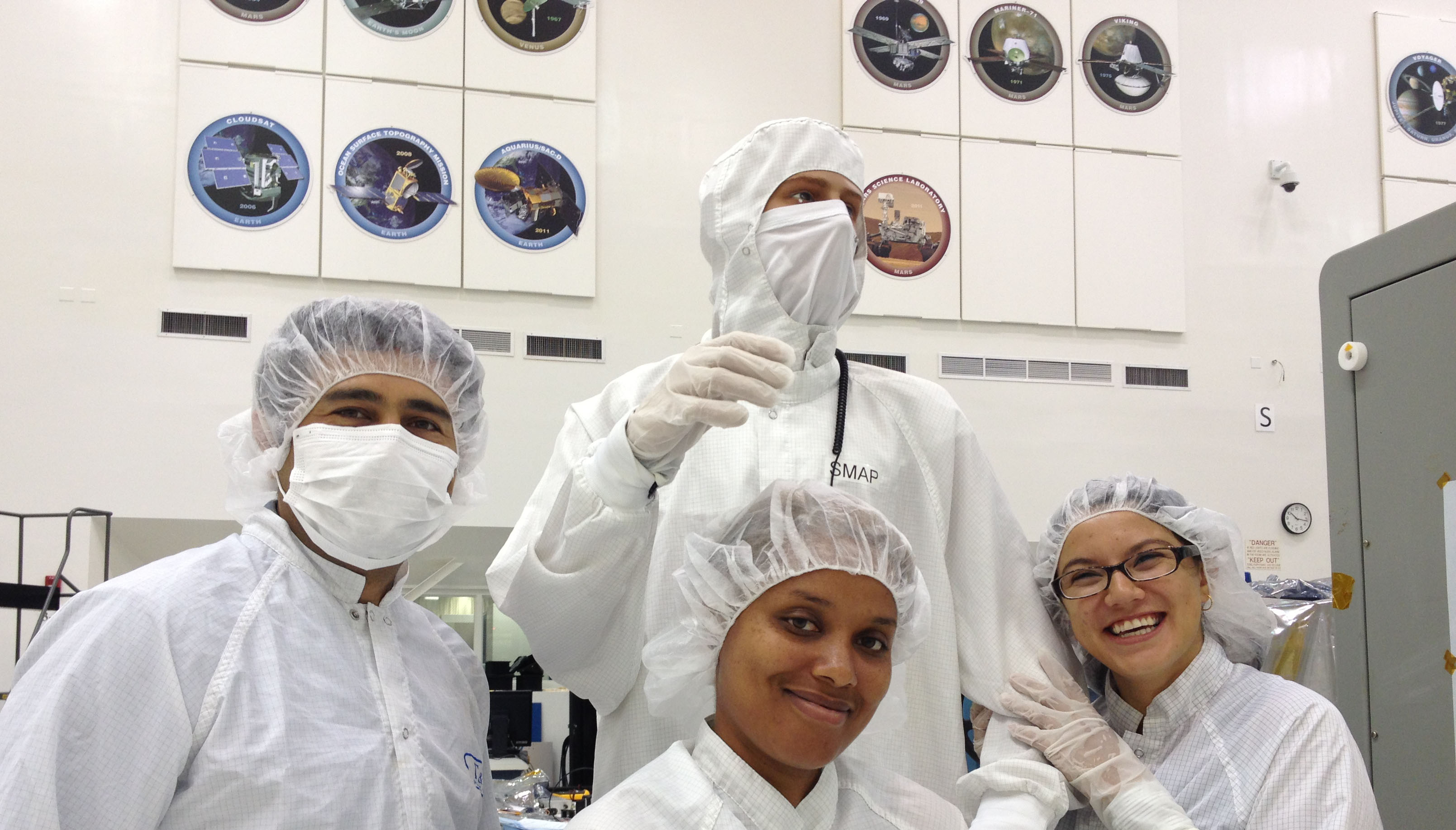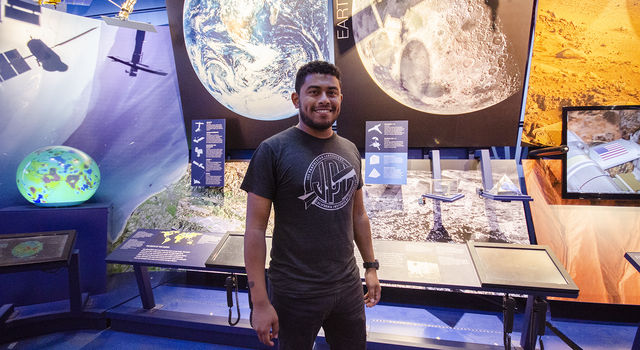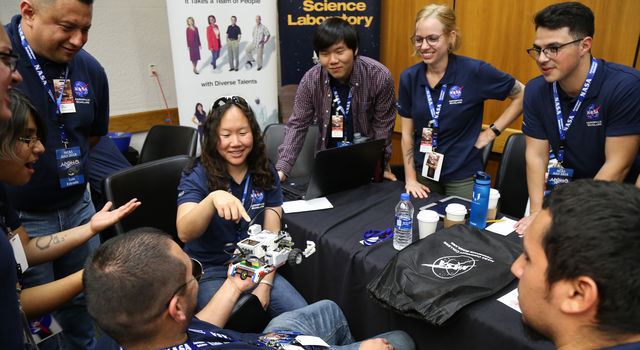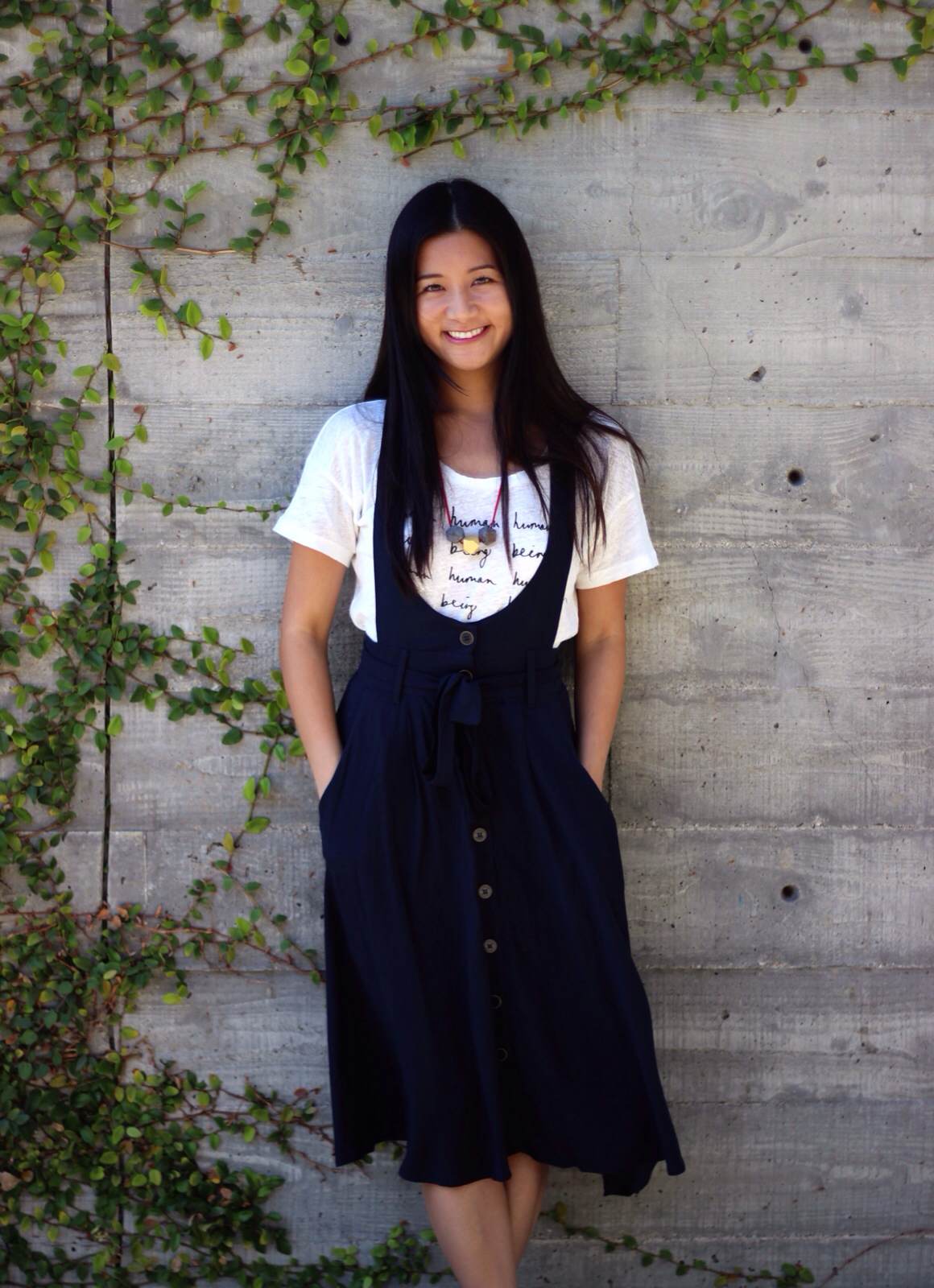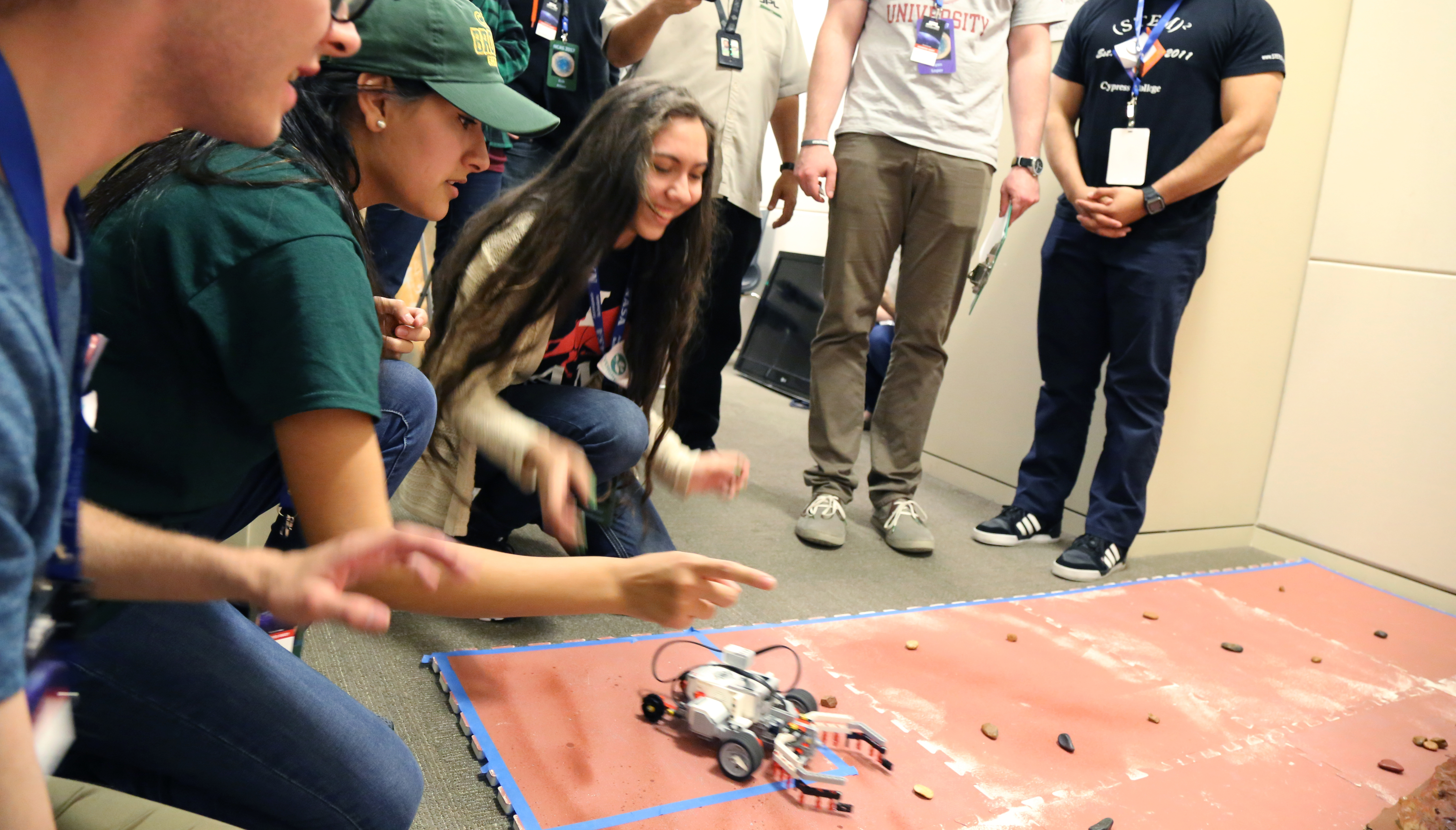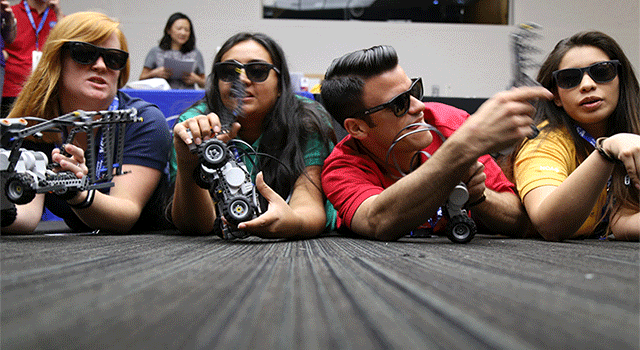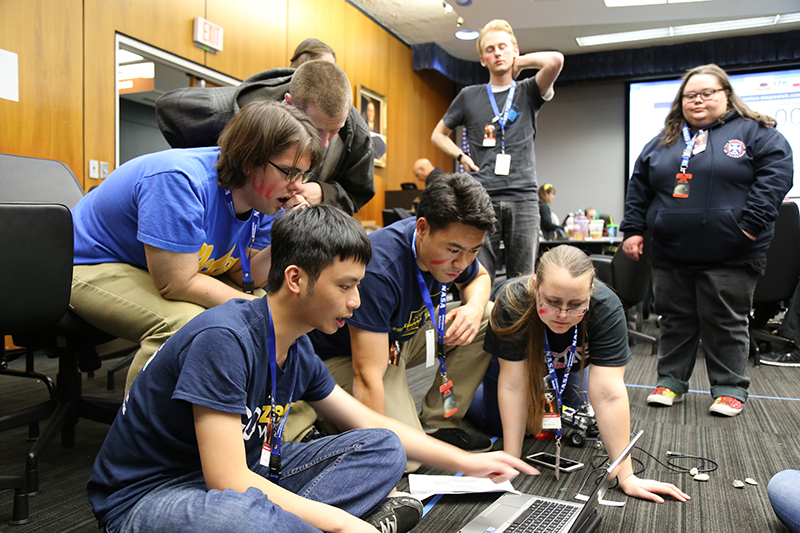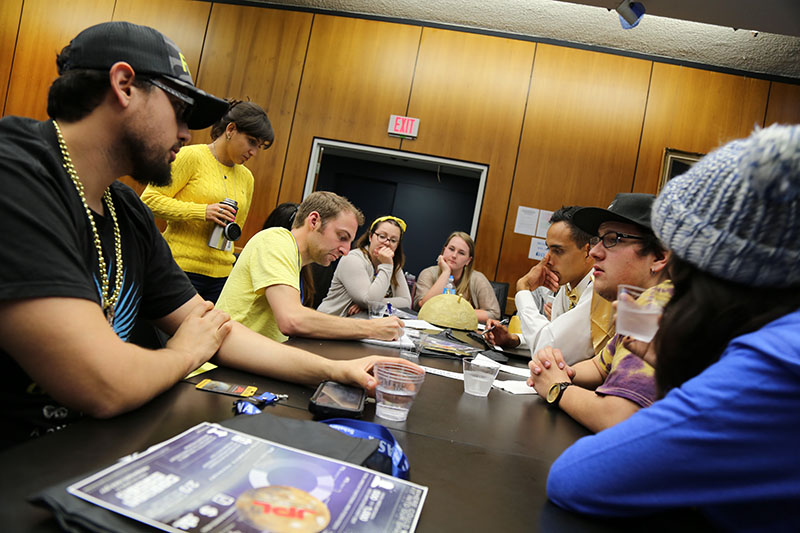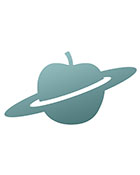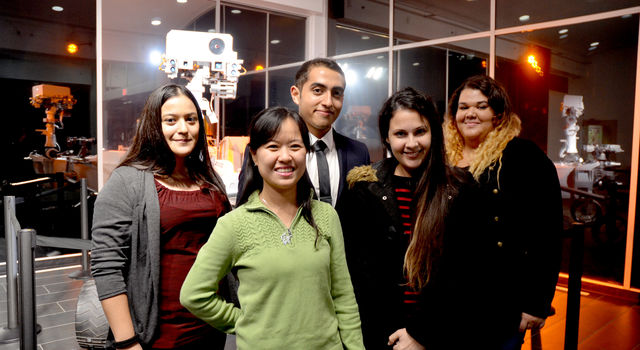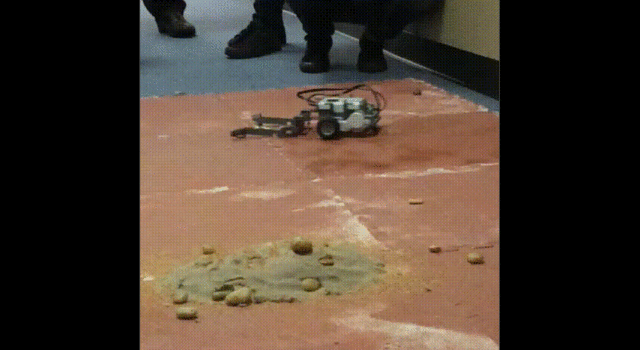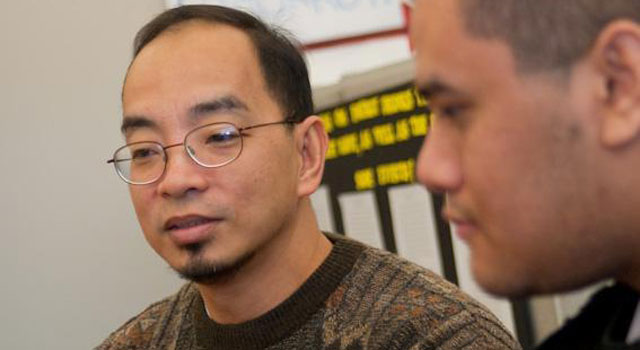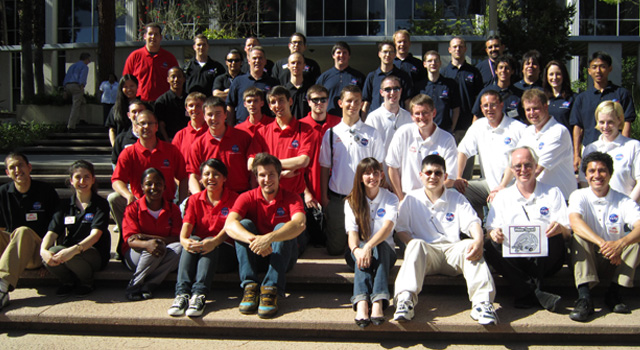Meet JPL Interns | May 19, 2022
Interns Lead the Way in DARPA Robotics Challenge and Find Their Futures
To gain an edge in one of the world's premier robotics competitions, JPL brought in a team of experts at the forefront of their field – college students. The experience gave the interns and the Laboratory a new perspective on what's possible.
You know that movie trope where a talented mastermind recruits a ragtag team of experts to pull off a seemingly impossible task. That's what I imagine when Ali Agha talks about the more than 30 interns brought to NASA's Jet Propulsion Laboratory to take part in one of the world's premier robotics competitions.
In 2018, a group led by Agha was one of only 12 teams chosen worldwide to compete in the Defense Advanced Research Projects Agency, or DARPA, Subterranean Challenge, a three-year-long competition that concluded this past September and brought together some of the brightest minds in robotics. Their goal was to develop robotic systems for underground rescue missions, or as Agha puts it, "solutions that are so state-of-the-art, there's not even a clear definition of what you're creating."
Calling themselves Team CoSTAR, which stands for Collaborative SubTerranean Autonomous Resilient Robots, the group also included engineers from Caltech, Massachusetts Institute of Technology, Korea Advanced Institute of Science and Technology, Sweden’s Lulea University of Technology, and several industry partners.
Meet some of the researchers, engineers, and interns who make up Team CoSTAR. Credit: NASA/JPL-Caltech | Watch on YouTube
Interns from across the country and around the world came to JPL to help conceive of, build, and test CoSTAR – a coordinated rescue team of flying, crawling, and rolling robots designed to operate autonomously, or with little to no help from humans. But the interns didn't just come to the laboratory to learn from engineers already well versed in building robots to explore extreme environments. In many cases, the interns were the experts.
"The problem we needed to solve, nobody knew how to solve it, so we needed people who are at the cutting edge of these technologies," says Agha. "We needed to get that one person in the world or a few people in the world who work on that specific camera or sensor or data or specific algorithm to come and educate us."
And Agha knew exactly where to find them: colleges and universities.
The interns' contributions would end up reaching far beyond the challenge. And the entire experience – from the mentorship they received to the technology they developed to the friendships they built – would change the course of their careers.
The Visionary
Even the Perseverance Mars rover, the latest and greatest Red Planet explorer designed and built at JPL, requires a fair amount of direction from mission controllers back on Earth to navigate around hazards and know which rocks to zap with its laser or when to phone home.
Since coming to JPL in 2016, Agha had been researching ways to make planet-exploring robots more autonomous so they could make similar decisions on their own. He was especially interested in autonomous technology for underground environments like caves and volcanoes, where the terrain and visibility make remote guidance challenging.
So when DARPA announced that it was launching a competition aimed at the development of autonomous robots for subterranean rescue missions, Agha jumped at the opportunity.
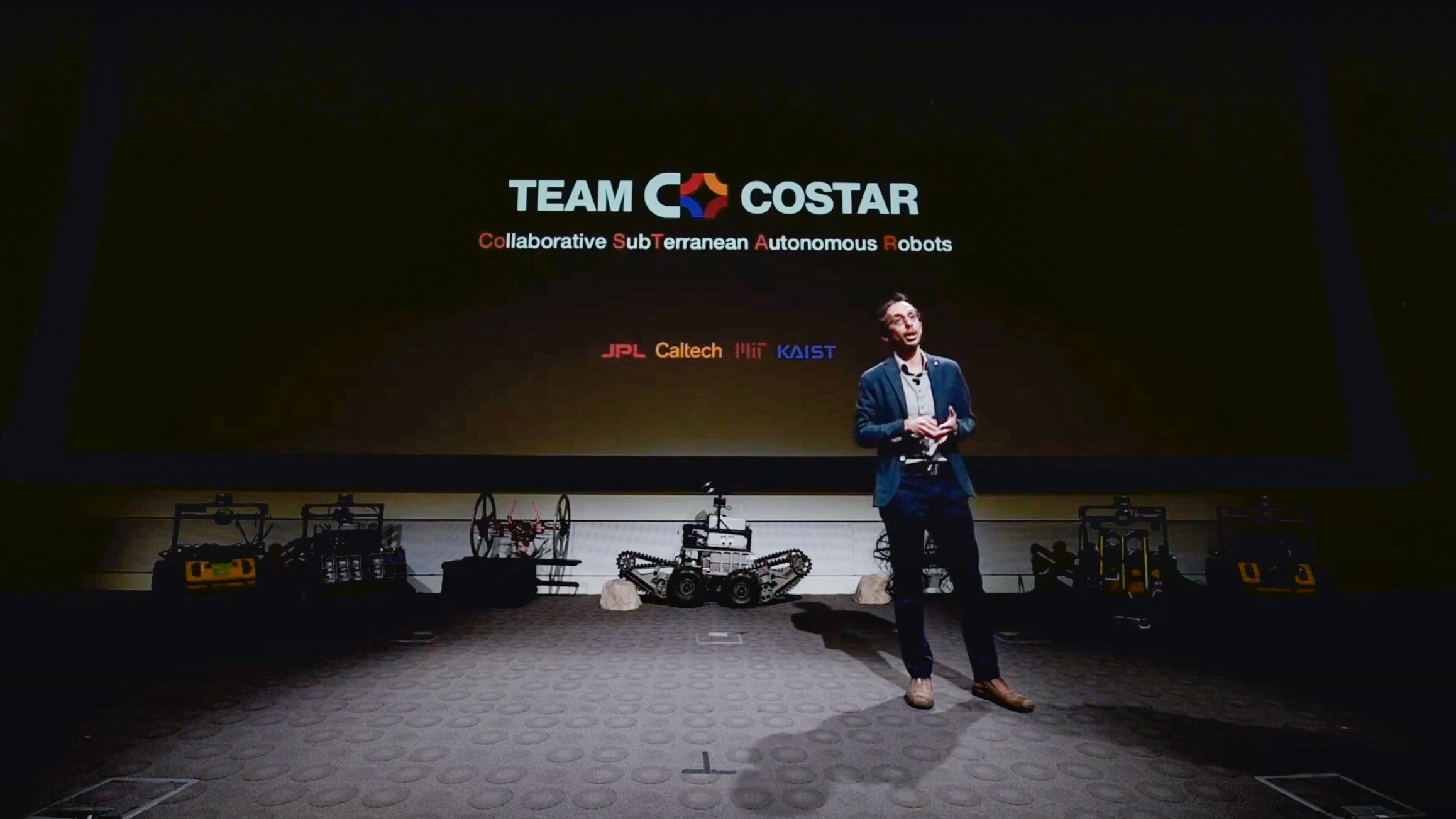
Agha gives a presentation at JPL about the technology developed for the DARPA challenge with CoSTAR's robot squad lined up behind him. | › Watch Agha's talk on YouTube | + Expand image
"It was a very good alignment and a great opportunity for JPL and for NASA," says Agha. "We knew if we can get into this program, it's going to expedite the technology development at a really high pace, and that's going to help NASA and JPL to develop these capabilities [for our own projects]."
But like developing robots for space exploration, the requirements would be tough.
Teams would need to build a robotic system that could autonomously navigate four circuits – a tunnel, an urban underground, a cave, and a combination of the three – in search of scientific "artifacts," or signs of human activity, hidden throughout the course. Then, in just 60 minutes, the robots would need to make their way through winding, cavernous, and dangerous terrain to correctly report the locations of as many artifacts as possible.
There were just 12 months between when proposals were selected and the first event in August 2019. Agha needed a plan – and a team.
The Strategist
Sung Kim first came to JPL as an intern in 2017, a year before the DARPA Subterranean Challenge was announced. A Carnegie Mellon doctoral student researching ways to help robots plan under uncertainty, Kim's childhood dream to work for NASA was rekindled when he saw an internship posting with Agha's team.
"From the first meeting, there was a spark," says Kim of his interview with Agha. "At the time, there were not many people actively pursuing that area [of planning under uncertainty]."
Kim spent that summer at JPL helping the team begin to develop what would later become the backbone of CoSTAR – a system in which robots can analyze their surroundings to find a route that covers as much ground as possible, increasing the odds that they will make discoveries along the way.
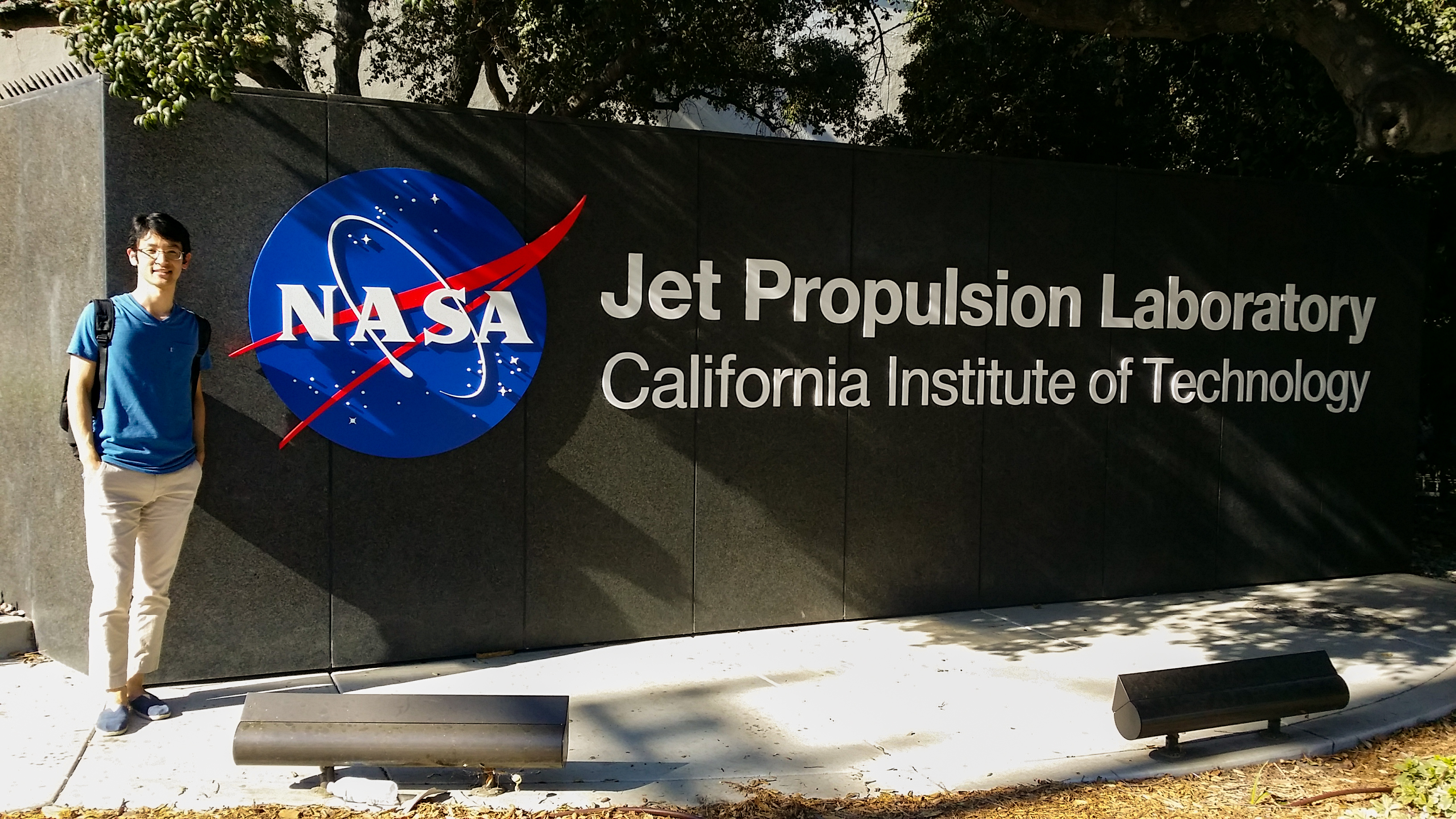
Kim poses for a picture with the JPL sign at the entrance to the Laboratory in Pasadena, California. Image courtesy: Sung Kim | + Expand image
For JPL's part, such technology could be key to designing robots to explore worlds like Jupiter's moon Europa, where the terrain is still relatively unknown. For CoSTAR, it would improve the team's chances of finding artifacts hidden throughout the challenge course, earning the team points toward a victory.
When JPL's DARPA proposal was selected a year later, Agha eagerly enticed the newly graduated Kim back to the laboratory, this time as an employee and the head of CoSTAR's Global Planning Team tasked with "maximizing the chances of finding artifacts hidden in the environment," says Kim.
Kim would be the first of a wave of students who would come to the laboratory over the next several years to lend their expertise in making CoSTAR a reality. In fact, one of them had already arrived.
The Detective
Xianmei "Sammi" Lei was looking to start over. She had come to the U.S. from China and become a legal permanent resident in hopes of finding better career opportunities. But she worried that her options would be limited while she was still making professional connections and learning English. That's when she discovered community college.
"One of the turning points for me here was realizing that we have something called community college," says Lei. "That gave me a lot of opportunities."
It was at Pasadena Community College that Lei started to build a network of peers and professionals and began her foray into the world of robotics. It was also where her passion for computer science was reignited, setting her on a trajectory to JPL and Agha's team.
"I took the beginning level of C++, and I liked it so, so much," says Lei. "I was like, 'Oh my god, you can realize your dreams through programming. That is so powerful!'"
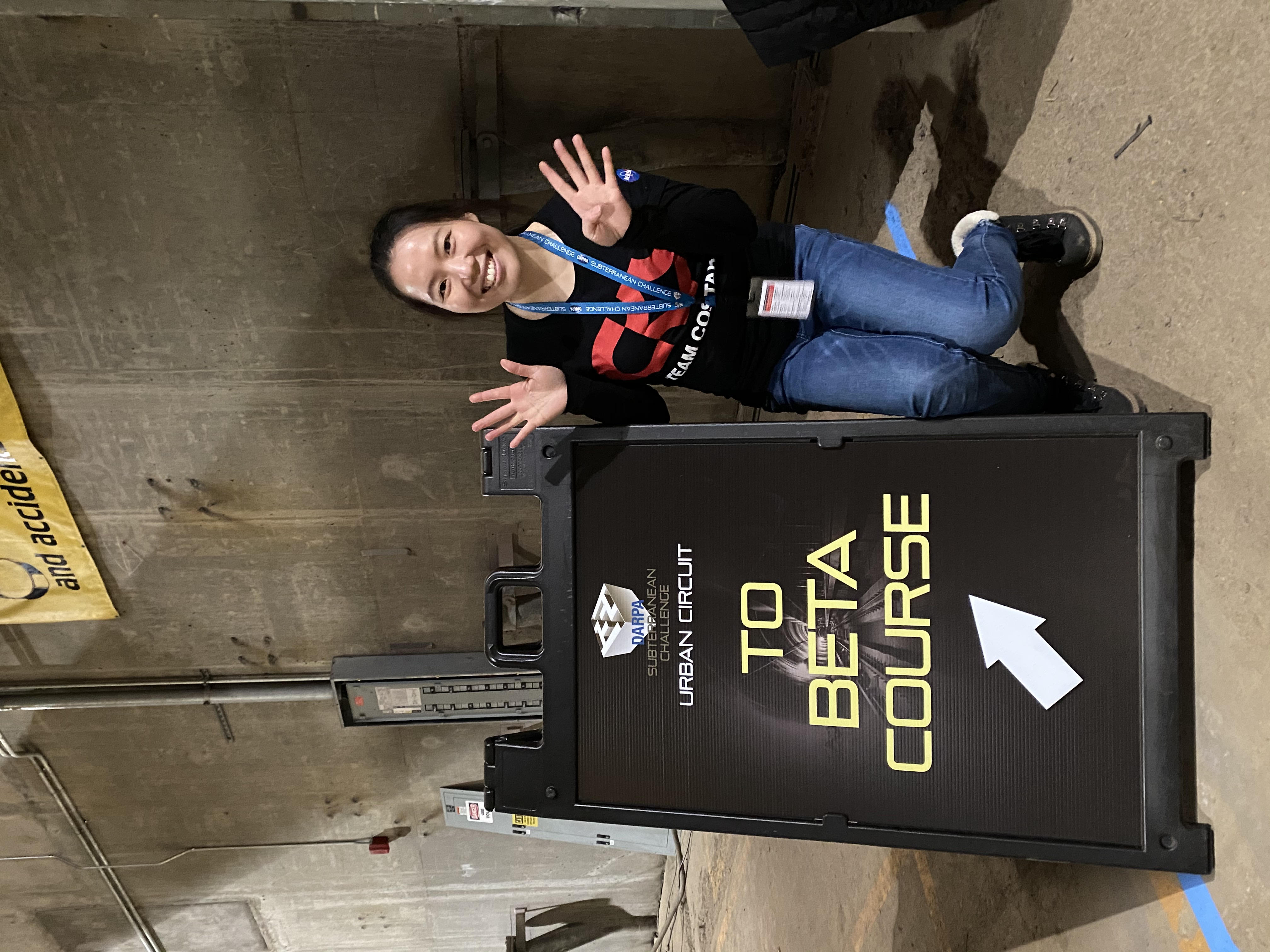
Lei poses outside the course area holding up nine fingers to represent the number of points won by the team during the Urban Circuit in February 2020. Image courtesy: Sammi Lei | + Expand image
Lei applied for an internship at JPL through the Student Independent Research Intern, or SIRI, program, which is designed to pair students from local community colleges with researchers at the laboratory. She caught Agha's eye thanks to her involvement in a swarm robotics competition. Still relatively new to the field, Lei spent her first internship in 2017 soaking it all in, learning as much as she could, reading papers assigned by Agha, and following him to meetings, she says.
At the encouragement of her growing network, Lei applied and was accepted to a master's program at Cal Poly Pomona. She went on to spend four more years at JPL throughout her graduate degree and the entire DARPA challenge. All the while, she played an integral role on CoSTAR as the person in charge of programming the system to detect the most coveted artifact of all.
"Inside the environment was a dummy that was simulating a human survivor with the same weight, same heat, wearing a safety vest, things like that," says Lei. "My job was to detect those signals with the robot and have it report back to the team so the human supervisor could verify."
But before that could happen, the system would need to overcome any number of hazards, which according to DARPA might include small passages, sharp turns, stairs, rails, large drops, mud, sand, water, mist, smoke, dead ends, slippery terrain, communications constraints, moving walls, and falling debris. The team needed a mobility expert.
The Navigator
"I was doing lots of mathy stuff," says David Fan of his doctoral research at Georgia Tech prior to coming to JPL in the fall of 2018.
Fan had been researching algorithms that could help robots learn to independently navigate complex terrain when his advisor told him about an internship opening on Agha's team with the JPL Visiting Student Researchers Program, or JVSRP. Fan saw it as a chance to take his work out of the theoretical and into the real world.
"Once I joined the team and started working on these robots in real life, it opened up a whole set of new problems that I had never thought about before," he says.
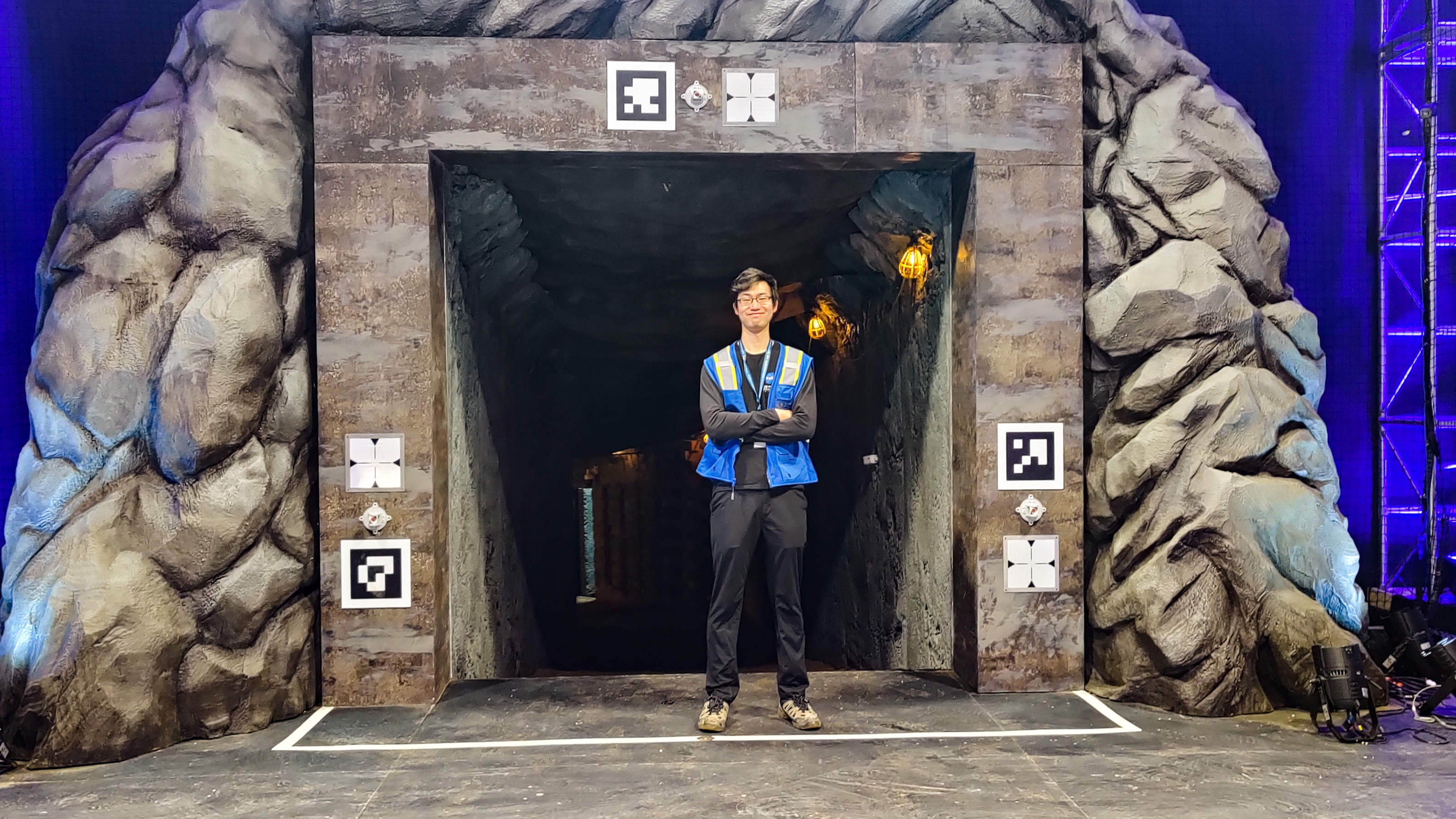
Fan poses in front of the entrance to the DARPA Subterranean Challenge Finals course in September 2021. Fan was one of a handful of team members chosen for the pit crew, which oversaw robot operations during the challenge. Image courtesy: David Fan | + Expand image
Problem one: How to get a robot through a hazard-filled course that requires a system with an almost contradictory set of features – small enough to get through narrow passages but big enough to support computing power, nimble enough to climb stairs and cross slippery terrain but strong enough to withstand falling debris.
Fan spent his early days with the team dreaming up robots with different kinds of locomotion – wheels, tracks, rotors, legs, and so on. Eventually, the team homed in on a solution involving all of the above, multiple robots with unique talents and ways of moving. Fan's doctoral research was key to unlocking how each robot could continually improve their skills, learning to navigate around obstacles as they encountered them.
Like their human counterparts, CoSTAR's robots each bring unique skills to the team, allowing them to autonomously explore caves, pits, tunnels, and other subsurface terrain. Credit: NASA/JPL-Caltech | Watch on YouTube
"Each environment would have its own set of challenges," says Fan, who interned with Agha throughout the DARPA challenge. "Trying to figure out where the robots could safely go in a subway was very different than where they could safely go in a cave or a mine. We broke a lot of robots. It was really fun."
But as often happens in engineering, one solution begets another problem. In this case it was how to coordinate multiple robots and get them working as a team.
The Field Commander
As a child in Indonesia, Muhammad Fadhil Ginting's favorite movie was a documentary about NASA rocket technology built to send astronauts to the Moon. He would watch it and rewatch it, dreaming of one day working at the space agency. But even after he had grown up to earn his bachelor's in engineering and begin to pursue his master's in robotics at one of the world's top universities, ETH Zurich, working for NASA seemed like a distant childhood dream.
That is until he saw an internship opening with Agha's team.
"Back in my undergrad in Indonesia, I was working with underwater robots to explore the ocean. When I found out JPL offered internships with the DARPA challenge team and it was about subsurface explorations, I was so excited," says Ginting who, like Fan, applied through JVSRP, which also brings in a small number of interns from foreign universities to work with JPL researchers. "I met Dr. Agha at an international conference and expressed my interest in joining his team. It was a thrill when he accepted me and welcomed me to the team."
When Ginting came on board, CoSTAR had just placed second in the Tunnel Circuit, the first of the four events.
After helping develop a strategy to coordinate the robots, Ginting was chosen for the team's exclusive "pit crew" along with just four others: Fan, also an intern at the time, and JPL employees Kyon Otsu, Ben Morrell, and Jeffrey Edlund.
On the pit crew, Ginting would have just 30 minutes to set up and release the robots into the subterranean course before he and the others were sequestered in a separate support area from Otsu, the sole robot supervisor. "It meant that I needed to be ready not just for the technical but also operational, anticipating all possible things that can happen in the field."
To prepare both the robots and the pit crew for handling the challenges ahead, the team took multiple field trips around California and to a limestone mine in Kentucky. When that wasn't possible, they sent the robots through cubicle mazes at JPL.
Ginting (shown at 0:18) and other members of team CoSTAR send the robots on a test run through Elma High School in Elma, Washington, in the days leading up to the Urban Circuit. Credit: NASA/JPL-Caltech | Watch on YouTube
Ginting fondly remembers the field trips not just for the opportunity to work out any bugs in the software, but also for the chance to pursue his other passion for outreach, giving talks to college students and kids and chatting up locals at the hotel breakfast bar.
"I liked meeting the community and sharing the excitement of building robots, the excitement of space exploration," says Ginting, who also saw the field trips as a chance to bond with his teammates.
When the Urban Circuit came around in February 2020, the team with Ginting's help earned a first-place spot. And then, COVID hit.
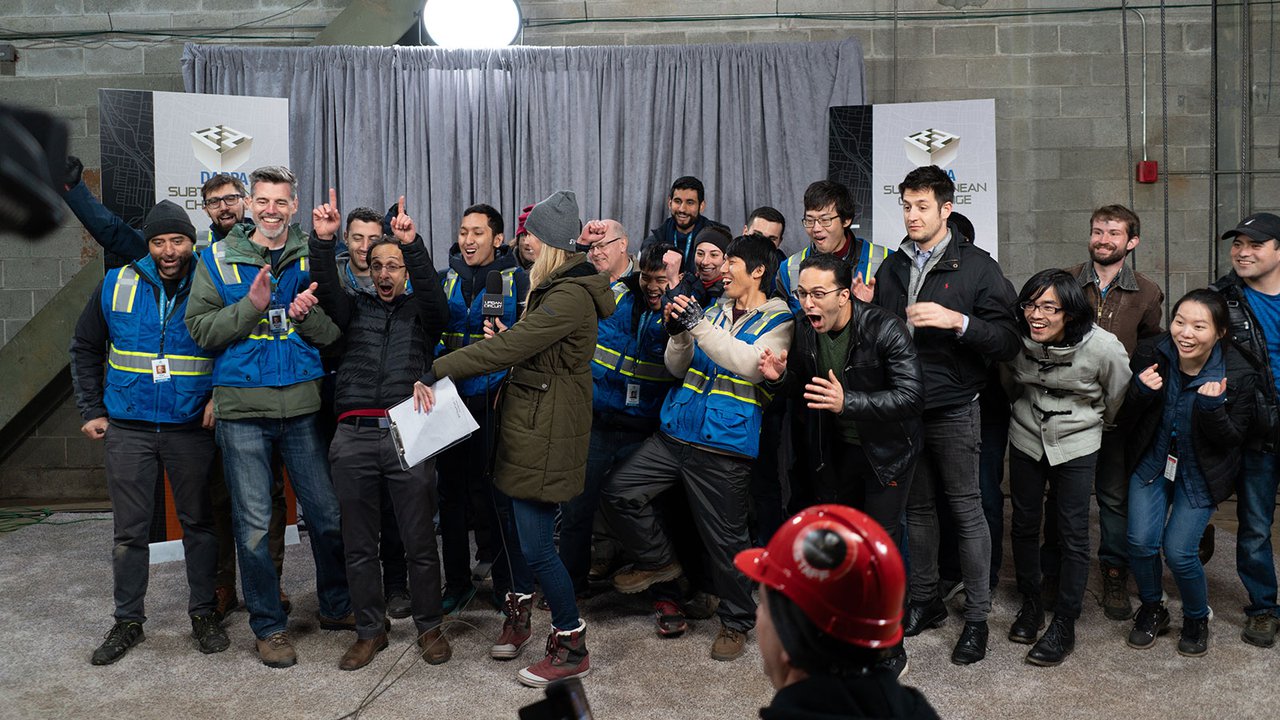
Team CoSTAR reacts to the news that they placed first in the Urban Circuit. Credit: NASA/JPL-Caltech | + Expand image
An Unexpected Challenge
Like it did with so much else, the pandemic threw the team and the competition for a loop.
Interns were sent home along with most of the rest of JPL's more than 6,000 employees, and the CoSTAR team had to learn how to do their work remotely. Lei recalls testing sensors from her home in Los Angeles or asking other team members to try them out in different environments.
In some ways, the remote work was good for the team. Rather than the intensive testing schedule, "people had more time for thinking," says Lei. Meanwhile, the team was able to bring on remote interns previously unable to travel to the Southern California laboratory.
The Cave Circuit, originally scheduled for November 2020, was canceled, but once vaccines began rolling out and restrictions on indoor gatherings were loosened, DARPA announced that the Final Event would take place in September 2021.
The Light at the End of the Tunnel
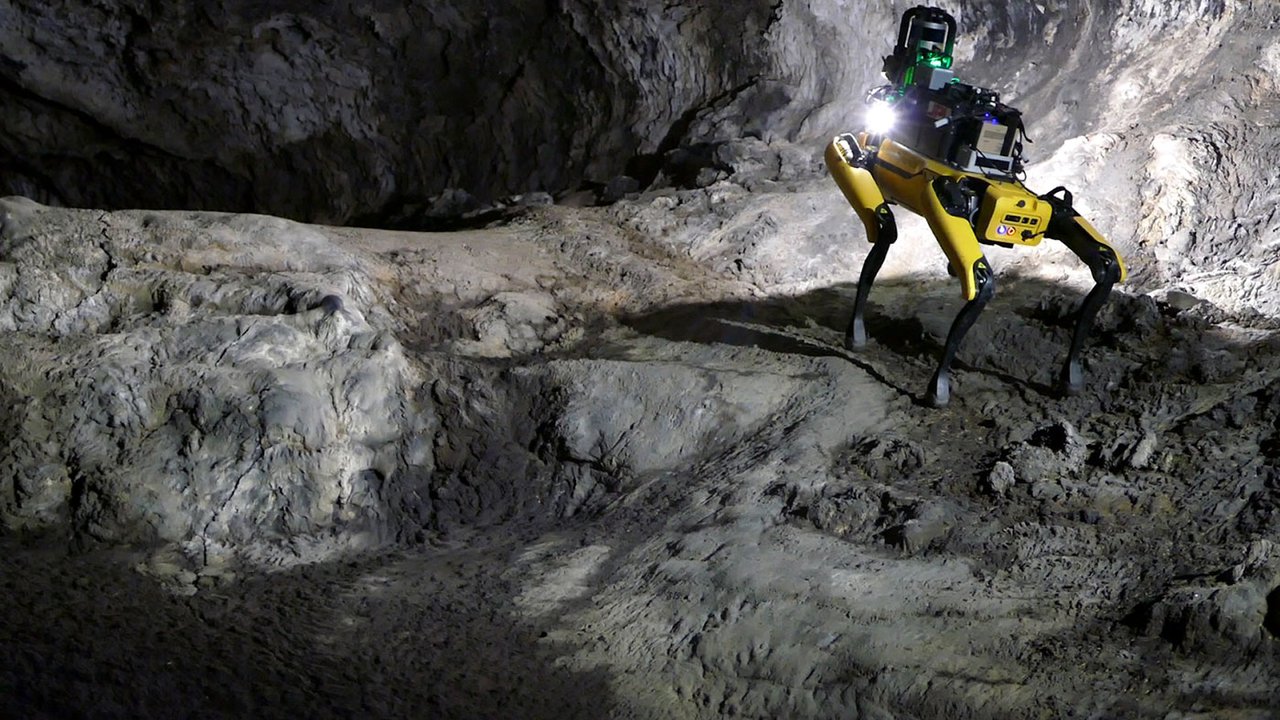
One of the team's robots named NeBula-Spot walks on four legs to explore hard-to-access locations, like this narrow cave. Credit: NASA/JPL-Caltech | + Expand image
"We were in pretty good shape – even in the preliminary rounds, we won with a good margin," says Agha. "But in the final event, our calibration system had an issue, so our robots entered the course 30 minutes late. It wasn't the kind of demonstration we were hoping to be able to have, but for that half of the time, it went really perfect."
While CoSTAR did not win the final competition, the overall experience was an unequivocal win not just for the team, but also for the interns and for JPL.
"We got all this great talent and technology – again, huge thanks to our interns and their mentors," says Agha. "They brought all this expertise to JPL, and the amount of capabilities that got developed really changed a lot about [autonomous technology] at JPL. We pushed state-of-the-art boundaries forward. We published strong papers and showed the world JPL's capabilities."
Already, the team's technology is making its way into a number of JPL and NASA projects including a snake-like robot designed to explore deep crevasses on icy worlds beyond Earth, self-driving offroad cars that could inspire future lunar exploration vehicles, and a project researching the possibility of finding microbial life within volcanic caves on Mars.
Many of the interns say the experience changed the course of their careers.
"It really set me on a different trajectory that I hadn't imagined before," says Fan, who is now working for the U.S. Navy in collaboration with JPL on the project to develop offroad self-driving vehicles. "It introduced me to so many of the real-world robotics problems that are out there waiting to be solved. It opened up a lot of doors and introduced me to a lot of people. It completely changed the trajectory of my Ph.D. and my career."
Lei was recently hired at JPL as a full-time employee, and she says she's looking forward to exploring new ways robots can assist humans in the future.
Kim continues to expand his research in new ways, taking part in JPL projects like Europa Lander, which hopes to send the first robot to explore the icy moon considered to be the next frontier in the search for life beyond Earth.
Ginting was accepted into a doctoral program at Stanford and is continuing his research collaboration with Agha and Kim. He says, "Now, I'm so eager to work on robotics research topics that can also work for space exploration."
In July, the entire team of about 150 people plans to meet up for a reunion cake party. Over the course of the challenge, cake parties had become an annual tradition for the tight knit group. They even managed to hold a virtual party in 2020. As with all things CoSTAR, the bakers go above and beyond to make cakes with life-like caves, moving parts, and LEDs.
When we talked, Agha flipped through photos of cake parties past and said that more than anything, it's this – the team camaraderie, the friendships – that is the greatest win of all.
The laboratory’s STEM internship and fellowship programs are managed by the JPL Education Office. Extending the NASA Office of STEM Engagement’s reach, JPL Education seeks to create the next generation of scientists, engineers, technologists and space explorers by supporting educators and bringing the excitement of NASA missions and science to learners of all ages.
Career opportunities in STEM and beyond can be found online at jpl.jobs. Learn more about careers and life at JPL on LinkedIn and by following @nasajplcareers on Instagram.
TAGS: Internships, Interns, College, Students, Community College, SIRI, JVSRP, YIP, Higher Education, Robotics, Engineering, Computer Science, Asian Pacific American Heritage Month
Meet JPL Interns | July 25, 2019
Science Points the Way to Stellar Career Path for NASA/JPL Intern
In high school, science was the last thing on Jose Martinez-Camacho's mind. But one day, he was flipping through his chemistry textbook, and a diagram caught his eye. It described an experiment that was the first to identify the structure of an atom. Martinez-Camacho was amazed that a science experiment could reveal the inner workings of something so mysterious. He was hooked. Now a physics major at Cal Poly Pomona and in his fourth year interning at NASA's Jet Propulsion Laboratory, Martinez-Camacho is immersed in unveiling the details of other mysterious objects: lunar craters. Using a simulation he developed, Martinez-Camacho is working to understand how the temperatures inside and around craters in the permanently shadowed regions of the Moon might point the way to water ice. We caught up with him to find out more about his internship and his career journey so far.
You've done several internships at JPL, starting in 2015. What are the projects you've worked on?
My first internship in the summer of 2015 was with the Lunar Flashlight mission. The idea of the mission is to reflect sunlight into the permanent shadowed regions of the Moon to detect water ice. My project was testing and characterizing the photodetectors that would be used to identify the water ice. So most of that project involved setting up an experiment to test those detectors.
My next internship was still with the Lunar Flashlight mission, but my project was to model the amount of stray light that the detector was expected to receive from the lunar surface.
After that, I started to work with the Lunar Reconnaissance Orbiter Diviner team. [Diviner is an instrument on the Lunar Reconnaissance Orbiter that creates detailed daytime and nighttime temperature maps of the Moon.] In that project, I was working with Catherine Elder to validate one of her algorithms that can identify the abundance and size distribution of lunar rocks in a single pixel of an image taken by Diviner. So I used the algorithm to analyze the rock populations around the Surveyor landers, which took images on the lunar surface that we could use to validate our results.
What I'm working on now is 2D thermal modeling of craters in the polar regions of the Moon. The end goal is to better understand the thermal environments of the Moon's permanently shadowed regions, which can harbor water ice. Because the stability of water ice is very sensitive to temperatures, knowing the thermal environment can tell us a lot about where these water-ice deposits might exist.

This temperature map from the Diviner instrument on the Lunar Reconnaissance Orbiter shows the locations of several intensely cold impact craters that are potential cold traps for water ice as well as a range of other icy compounds commonly observed in comets. Image credit: NASA/GSFC/UCLA | + Expand image
What is your average day like on your current project?
I'm using MATLAB to write code [that I use to model the craters]. I wrote the code from scratch. Right now I'm at the point where I've written the program, I've gone through most of the debugging and the derivations of the equations and picking the algorithm, so I'm just running the model and waiting for results. So an average day would be to come in and run the model for different cases. There's a range of crater diameters and a range of latitudes where permanent shadows exist, so I run the model for these different cases, wait for the results and interpret the results at the end of the simulations. I also do some debugging now and then to deal with problems in the code.
What got you interested in a science career?
I think it happened in my junior year of high school. I was always disinterested in school and never paid attention. In chemistry class, we were learning about the atom, and for some reason, I opened up my chemistry book at home and started looking at the diagrams. I found a section on the Rutherford gold foil experiment, which showed that atoms consist of a tightly packed positive nucleus surrounded by electrons. I was amazed that someone could deduce that from a simple experiment. So that sparked my interest in science. After that, I started to read about chemistry and astronomy and all types of science. That was the pivotal moment.
How did you pursue that career path, and were there any challenges along the way?
I knew I'd have to go to community college because, at the time, my GPA wasn't going to get me anywhere. So I knew I had to start at the very, very beginning. But I had a very clear plan: Just keep studying, keep getting good grades until you get to where you want to be.
Sometimes students – especially community college students – feel intimidated applying for JPL internships, even though they should absolutely apply! Did you feel that way at all, and if so, how did you overcome that fear?
I was almost not going to submit my application just because I thought I wasn't good enough to intern at JPL. But ultimately, I had nothing to lose if I got rejected. It would be the same outcome as if I didn't apply, so I submitted my application. And I was really surprised when I got the acceptance letter.
What was your first experience at JPL like?
Everything was super-unfamiliar. I was in a lab, working on a science instrument, and I wasn't an instruments guy. But I got a lot of help from other people who were on the project. Even though it was difficult, it made it very enjoyable to always have someone there with the right answer or a suggestion.
How has your time at JPL molded your career path?
I think it established it. Next year, I'm going to Southern Methodist University to start a geophysics Ph.D. and my graduate advisor is someone who I met at one of the Diviner team meetings. Being at JPL has made that connection for me. And through JPL, I found what I want to do as a career.
What is your ultimate career goal?
After grad school, it would be really, really nice to come back here as a research scientist.
Are you interested in lunar research or anything planetary?
I think I'm really biased toward the Moon just because it's been my focus throughout my JPL internships. But I could see myself studying other planets or bodies. Mercury is very similar to the Moon. Anything without an atmosphere will do. That's what I'm comfortable with. If you add an atmosphere, the science is different. Ultimately, I think I'm interested in planetary science; it's just a matter of learning new science and learning about new planetary bodies.
Well, that leads nicely into my fun question: If you could travel to any place in space, where would you go and what would you do there?
I think I'd go somewhere around Saturn, or a moon of Saturn. Looking up from one of Saturn's moons would be a pretty amazing sight, with Saturn and its rings on the horizon.
Going back to your career path so far, did you have any mentors along the way?
In high school, I don't think so. I just needed to graduate. But in community college, I was part of this program called EOPS, or Extended Opportunity Programs and Services. It's for minorities and disadvantaged groups. There's counseling involved with people who knew what someone like me might be struggling with. There was that support group throughout my time at Citrus College. And there was also the Summer Research Experience Program [at Citrus.] That's the one I applied to in order to get the summer internship here. It was through Citrus College's partnership with JPL. One of the people who was in charge of that, Dr. Marianne Smith, she was always encouraging me, saying, "Just because you come from a community college doesn't mean you're any less than someone who is at UCLA or any other university." So that was another source of support.
Did you see advantages to going the community college route?
Yeah, definitely. It's a smaller community, so you get to form connections a lot easier than you would at a larger college. The quality of education there is probably on par with other universities. So, there was certainly no disadvantage. And then there was that advantage of the smaller community. It's more personalized and easier to get help.
What would you recommend to other students in community college who are interested in coming to JPL?
Apply to the program. Take advantage of the summers and apply to internships. At Citrus College they have the Summer Research Experience Program, and they probably have something similar at other community colleges. Take advantage of that. If I hadn't applied to that program that summer, my life would be totally different. Those decisions can shape your future.
Explore JPL’s summer and year-round internship programs and apply at: https://www.jpl.nasa.gov/edu/intern
The laboratory’s STEM internship and fellowship programs are managed by the JPL Education Office. Extending the NASA Office of STEM Engagement’s reach, JPL Education seeks to create the next generation of scientists, engineers, technologists and space explorers by supporting educators and bringing the excitement of NASA missions and science to learners of all ages.
TAGS: Higher Education, College, Internships, Interns, Science, Moon, Community College, Students, Hispanic Heritage Month
Edu News | July 15, 2019
Community College Students Build Rovers and Their Futures During NCAS Workshop at NASA/JPL
Last week, 40 community college students landed at NASA's Jet Propulsion Laboratory to accept the challenge of building miniature Mars rovers over the course of four days, from July 9-12, putting their designs to the test in a series of competitions on simulated Martian terrain.
The challenge is part of the National Community College Aerospace Scholar, or NCAS, program, which hosts hundreds of students across multiple NASA centers for a twice-yearly educational workshop and engineering competition. The activity provides students with an up-close and intimate look at NASA missions, and an opportunity to present their work to a panel of judges.
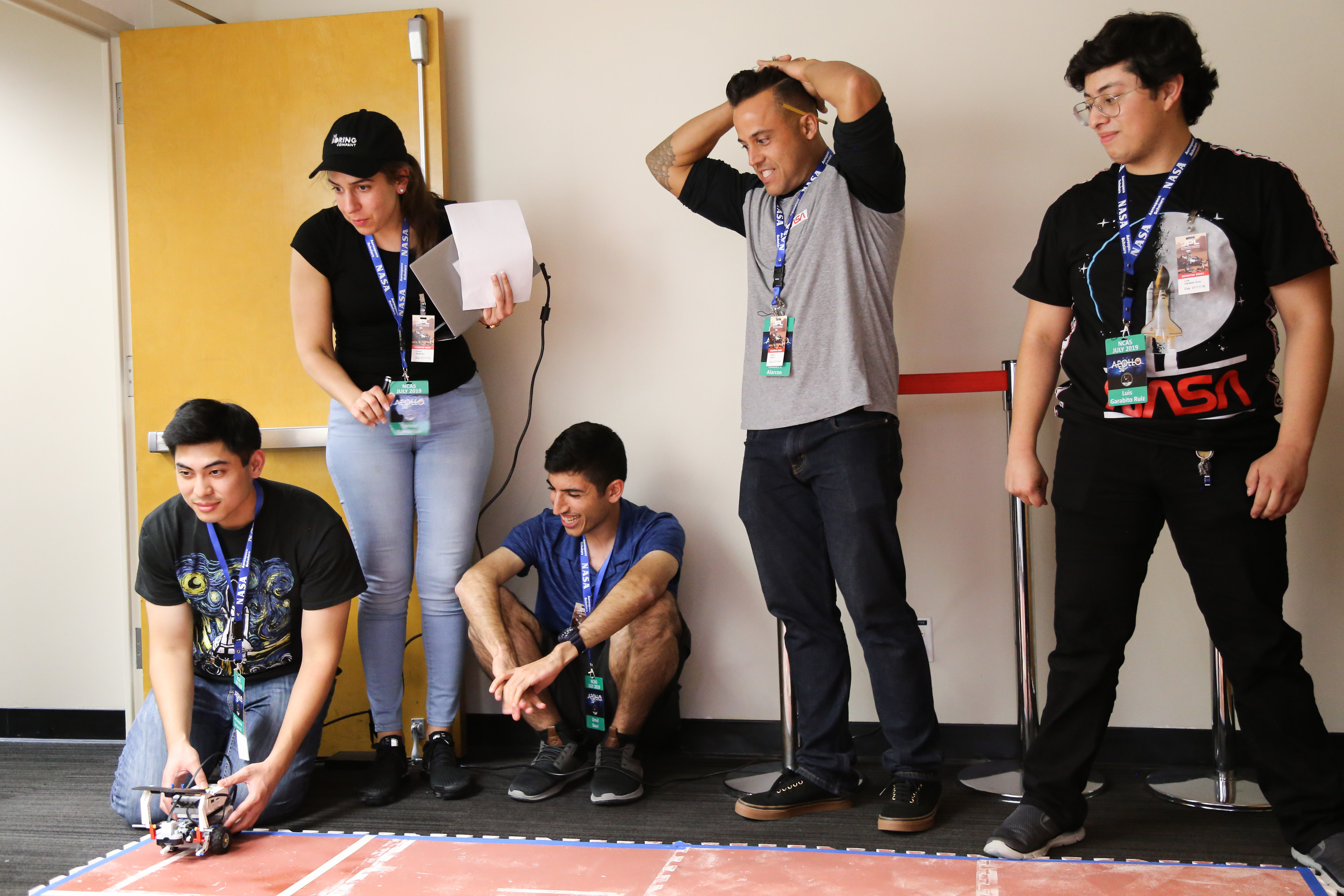
Students ready their rover to compete in one of two challenges that took place during the activity at JPL. Image credit: NASA/JPL-Caltech/Lyle Tavernier | + Expand image
One key part of their week here: The students, who are divided into four teams, are mentored by NASA scientists and engineers. And at JPL – where the competition is organized by the Education Office – nobody knows the mentorship experience better than Amiee Quon and Otto Polanco, JPL's two longest-serving NCAS mentors.
In 2012, Quon – who participated in the high school version of NCAS when she was 16 – saw an email circulated at JPL requesting mentors for the competition. She signed up and has been a mentor ever since.
“It’s so rewarding to see how excited they are about engineering, and when they work hard on something and collaborate, that things work out for them,” says Quon, a mechanical integration engineer who has worked on the Mars 2020 helicopter and the Juno mission orbiting Jupiter, and is currently working on the Europa Clipper mission.
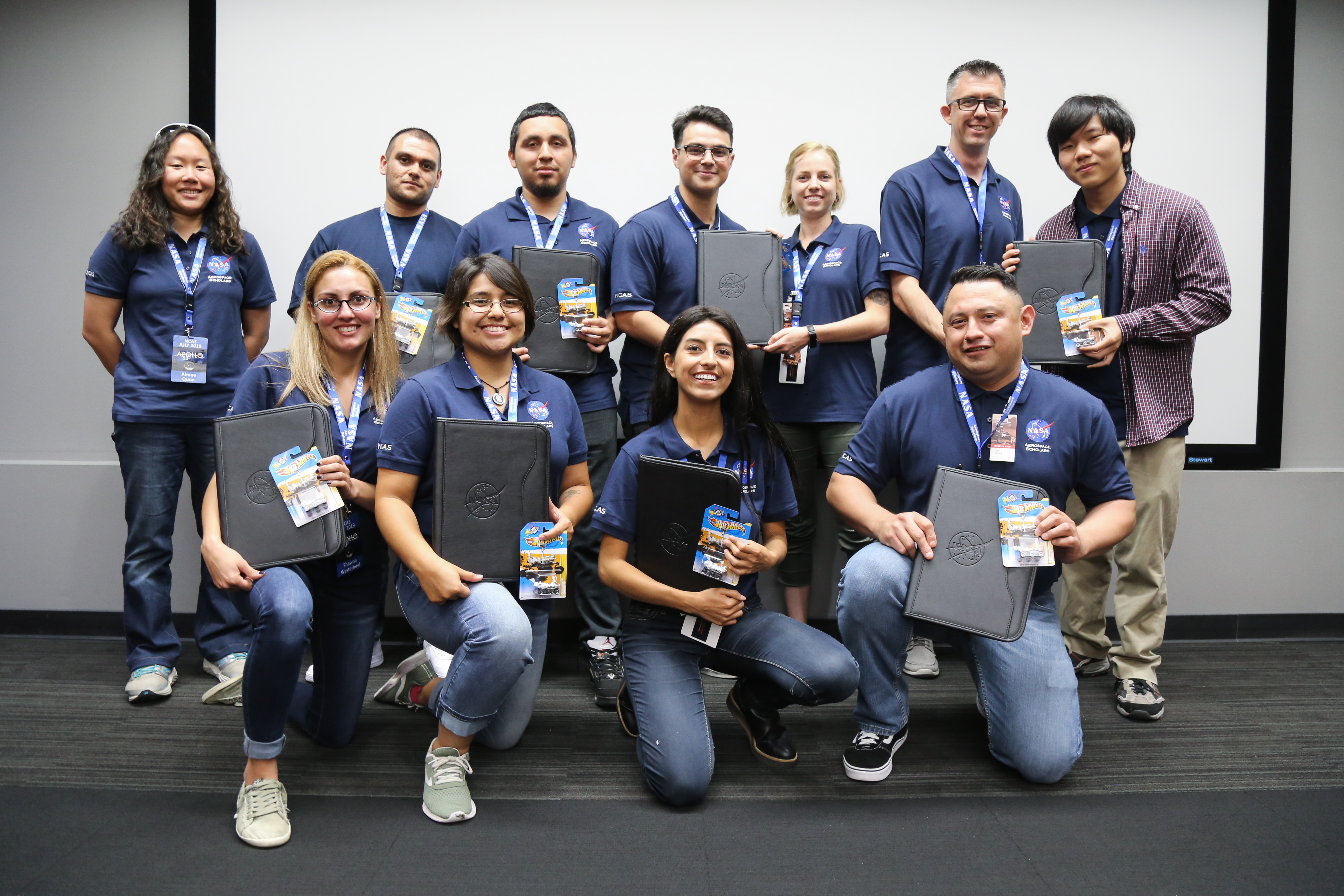
Quon's team poses for a photo with their winnings from the summer 2019 competition. Image credit: NASA/JPL-Caltech/Kim Orr | + Expand image
Things worked out especially well for Quon's mentees this session: The 10 students on her team were named the winners of the summer 2019 competition.
“My team was very cohesive, and I was impressed by how well they worked together to design, build and operate their successful rover,” she says. “All the teams did a great job on the toughest competition course I’ve ever seen.”
For Polanco, being a mentor is a capstone on his own experience as a community college student. He started his undergraduate studies at Santa Monica College, transferred to Cal State L.A. to earn his bachelor’s and master’s degrees in mechanical engineering, and eventually landed an internship at JPL. He's been at JPL for 15 years and has worked as an optical-mechanical engineer on the Mars Science Laboratory mission, Starshade project and more.
The NCAS competition is an opportunity for Polanco to encourage students to go after what they want to do – including helping one female college freshman, whose family expected her to marry and have children instead of chasing a STEM career. Polanco guided her during an NCAS competition and stayed in touch throughout her college years; today, she’s pursuing a Ph.D. at Caltech and studying global climate change.
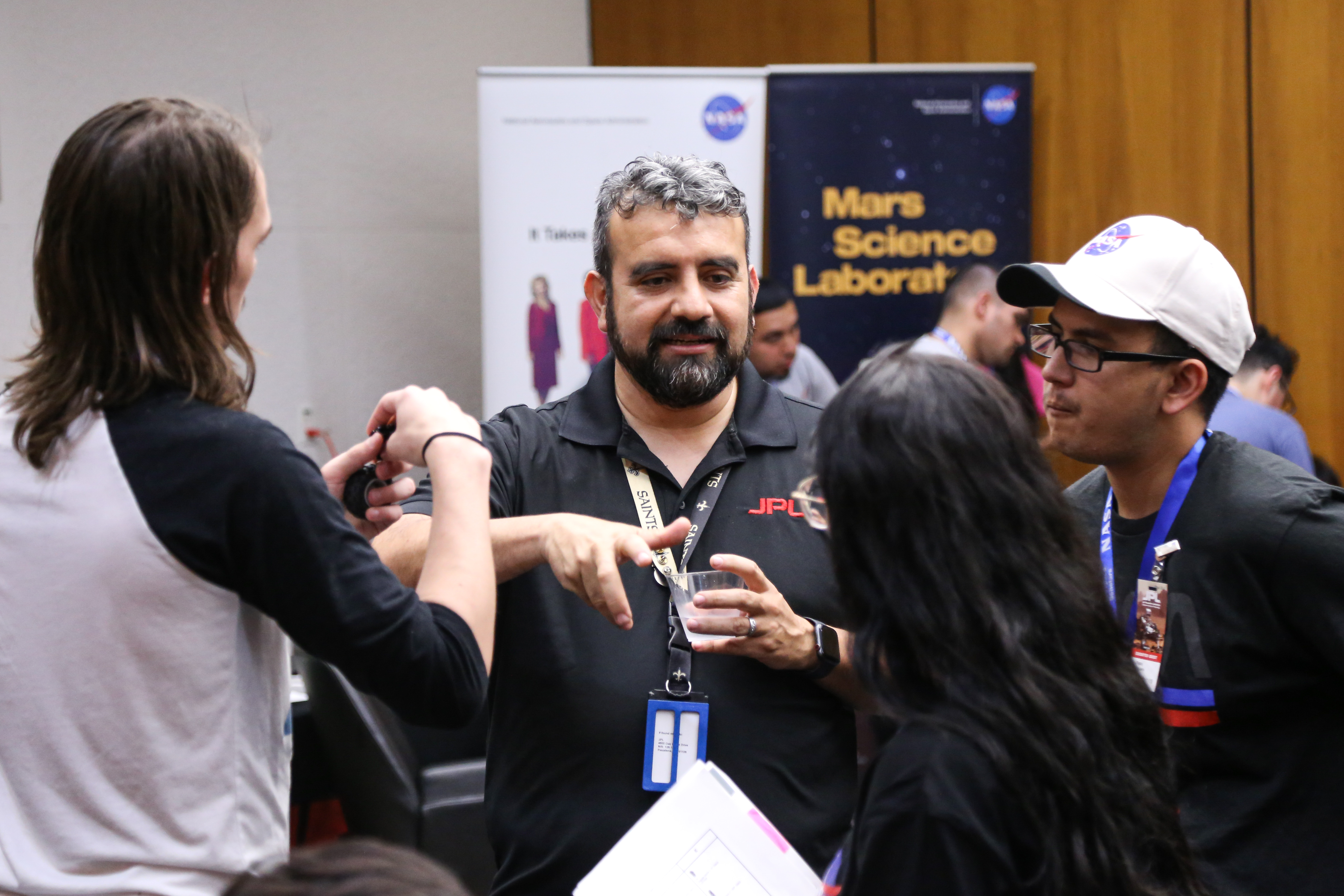
Polanco speaks with several of his mentees during the summer 2019 session of NCAS. Image credit: NASA/JPL-Caltech/Lyle Tavernier | + Expand image
“The most rewarding part is influencing people’s perspectives about what their engineering futures might be,” he says. “It’s about convincing them to pursue their dreams and passions and seeing them grow over the years.”
While Quon and Polanco play a big part in helping guide the students through various Mars rover challenges and their final presentations, they both recognize that their ultimate roles lie in reminding students that they deserve to achieve anything they set their minds to.
“A lot of our mentorship is raising the confidence levels of individuals,” Polanco says. “It’s through these side conversations that you often hear, ‘I’m not qualified or worthy enough to work here.’” And I always ask them, ‘Why do you put a ceiling on yourself?’”
Adds Quon: “We talked to somebody during the competition who felt they would be at a disadvantage going to career fairs because they transferred [into their current university]. But you’ve worked hard to get to where you are. There’s absolutely no reason to feel 'less than.'”
To that end, Polanco encourages more people at JPL to mentor when they can.
“I think it’s a really good experience for JPL employees to go through, to see how their own experience can help others,” he says. “My little path is a good example of what people can do. There are so many students in community college who struggle to see that end achievement. But the institution is good about hiring talent and [individuals with] strong work ethic, no matter where you went to school.”
The NCAS program is funded by the NASA Minority University Research and Education Program. Learn more and apply, here.
TAGS: Higher Education, Community College, NCAS, Mentors, Students, STEM, Engineering
Meet JPL Interns | June 27, 2017
Community College Students Design Rover Missions at NASA/JPL
Forty community college students from across California spent a week designing Mars rover missions at NASA’s Jet Propulsion Laboratory as part of the Spring 2017 session of NASA’s Community College Aerospace Scholars, or NCAS, program.
Selected from nearly 1,000 applicants, the students toured JPL in Pasadena, California, met with scientists and engineers, and attended career and resume workshops. But the main event was a series of competitions that pitted four teams’ rovers against one another on a simulated Mars terrain.
Led by JPL mentors, the teams had just a few days to build and refine autonomous rovers from Lego Mindstorms EV3 kits. After competing in two challenges, the teams presented their rover mission concepts to a panel of judges and a winning team was announced.
To learn more about the program and apply, visit: https://nas.okstate.edu/ncas/
Explore more NASA/JPL internship opportunities at: https://www.jpl.nasa.gov/edu/intern
The laboratory’s STEM internship and fellowship programs are managed by the JPL Education Office. Extending the NASA Office of Education’s reach, JPL Education seeks to create the next generation of scientists, engineers, technologists and space explorers by supporting educators and bringing the excitement of NASA missions and science to learners of all ages.
Meet JPL Interns | April 14, 2016
Live Blog - NCAS Spring 2016
Thursday, April 14
3 p.m. - Firsts and Thanks ... Until Next Time
Once the group photos were taken and the rovers dismantled, students gathered in the conference room where they had spent most of the last four days. Where rover parts, notebooks and laptops once stood, now it was just 40 suitcases laying in wait for the return home. But the experience wouldn’t end until awards and several rounds of thanks were given to the organizers, mentors and students who made the experience possible – and as program coordinators Roslyn Soto and Eddie Gonzales were sure to point out, contributed to a number of firsts for the National Community College Aerospace Scholars program.
The networking challenge and planetarium show were among some of the firsts. As was the first female majority among the team’s project managers (three of four were women) as well as the number of women participating in the on-site experience overall.
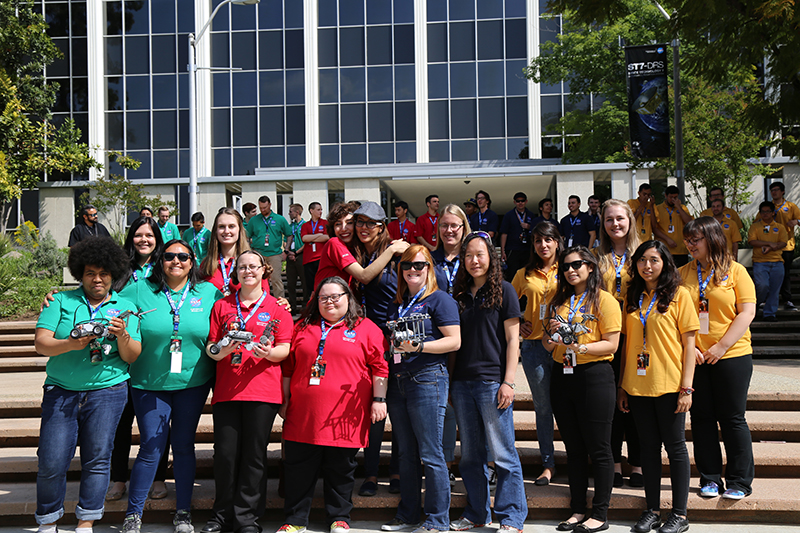
By the time the winning team was announced, the students were so full with congratulations that they seemed to have almost forgotten there was a winning team at all. But it didn’t dull the Blue Team’s celebration when, without further ado, they were announced as the winners by (another first) the smallest margin ever.

Soto and Gonzales said the level of teamwork – even between teams – was one of the biggest standouts of this session of NCAS and urged future teams to take note.
“The collaboration between teams was a thing of beauty,” said Gonzales. "It felt more like one huge team versus four individual teams. They helped each other in every facet of the competition and were graceful and showed incredible sportsmanship like I've never witnessed before."
With round after round of applause and standing ovations for Soto and Gonzales, the students, mentors and program coordinators said their final goodbyes, and by 2 p.m., the once hectic conference room was dark and quite … that is until the next crop of hopeful students arrives this fall.
> Learn more about NCAS and apply for the Fall 2016 session
> See a collection of photos from the Spring 2016 session
> Explore all the internship and fellowship programs at JPL and apply
10 a.m. - The Final Challenge
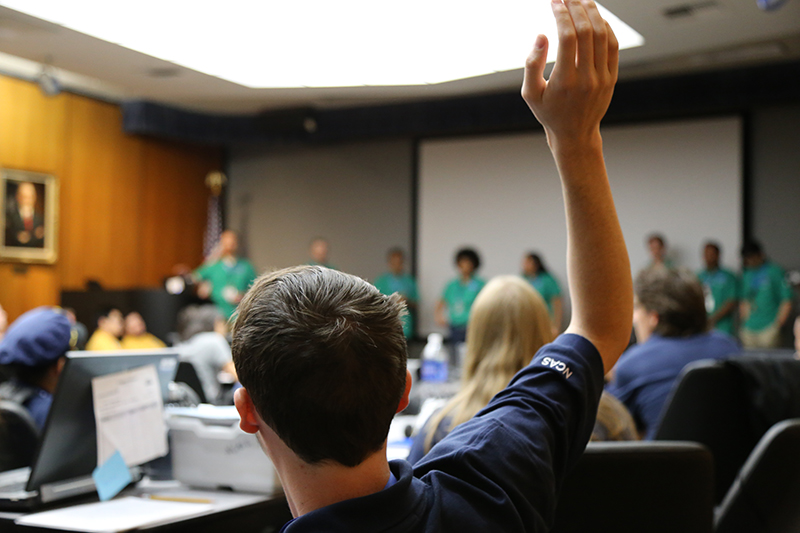
Today, on the fourth and final day of the NCAS on-site experience, students had one more challenge before the scores were tallied. They had five minutes to make a presentation to a mock "NASA Headquarters panel” about why their rover mission should be green-lighted. Channeling their inner Steve Jobs, the teams used music, videos, lighting and of course their rovers to make their case.
The Gold Team impressed with their marketing video that used two LEGO figurines (borrowed from their mentor) to tell a story about two people on a quest to add a rover to their family.
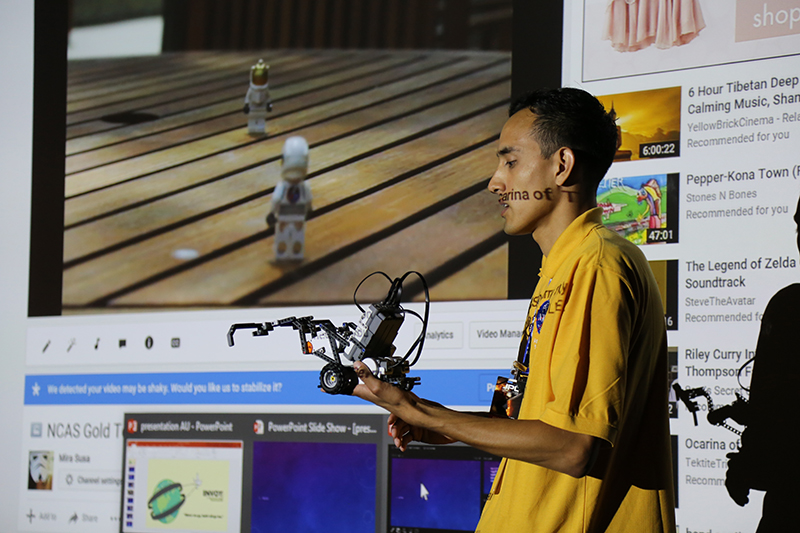
The Red Team started their presentation with a dance and later presented “scholarship certificates” from their reserved education budget to the JPL Education Office staff and other NCAS helpers.
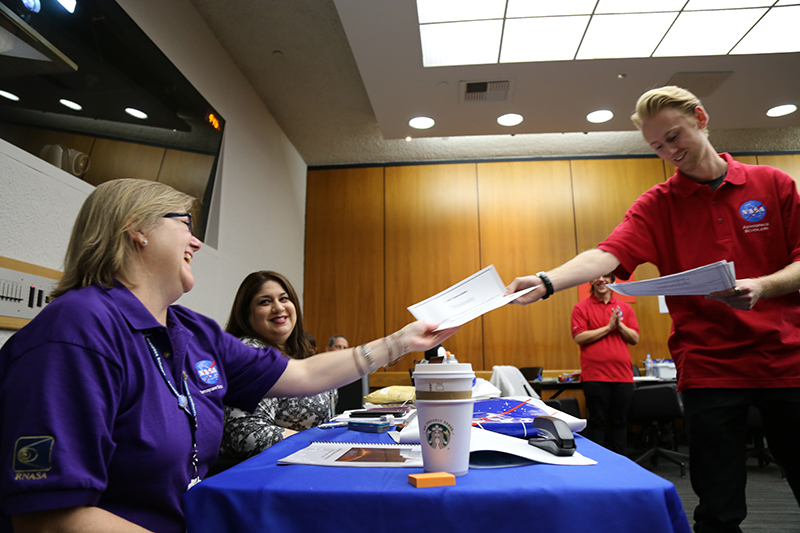
The Blue Team got laughs for a slide on their mission objectives, which was introduced by audio of Lakers basketball star Kobe Bryant saying, “Success on success on success.”
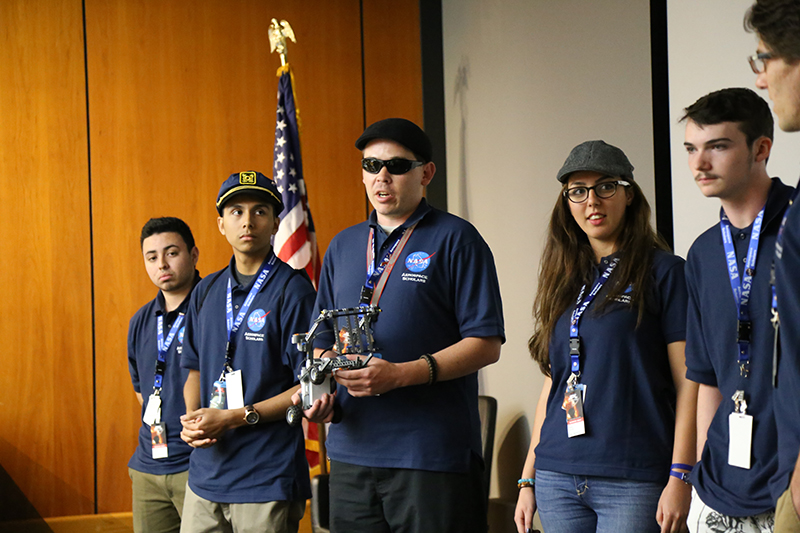
And the Green Team, which took the either coveted or dreaded task of being first to present, showcased their teamwork by sharing the stage to present the various facets of their mission.
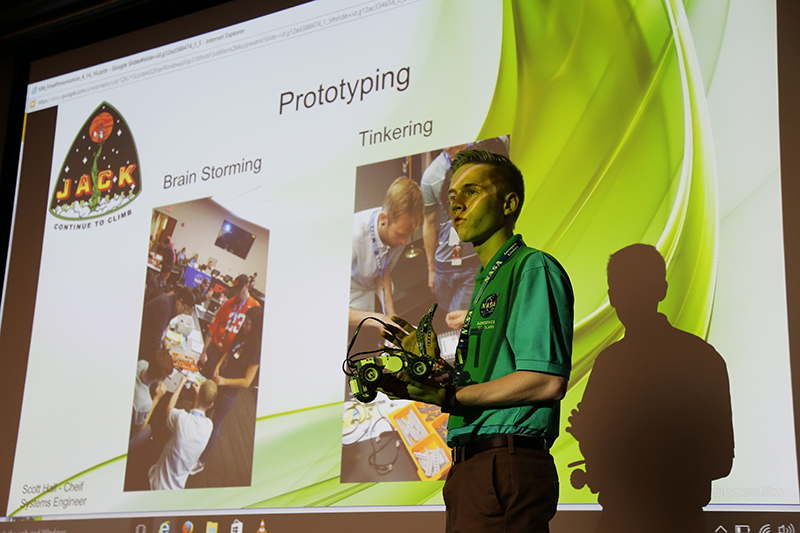
When presentations were over, it was time for the customary group photos and then perhaps the hardest part of the on-site experience: dismantling the rovers and packing up.
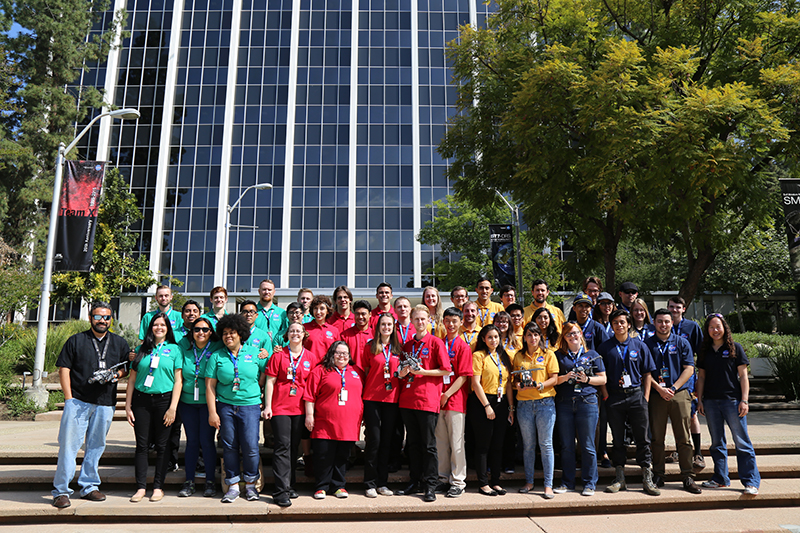
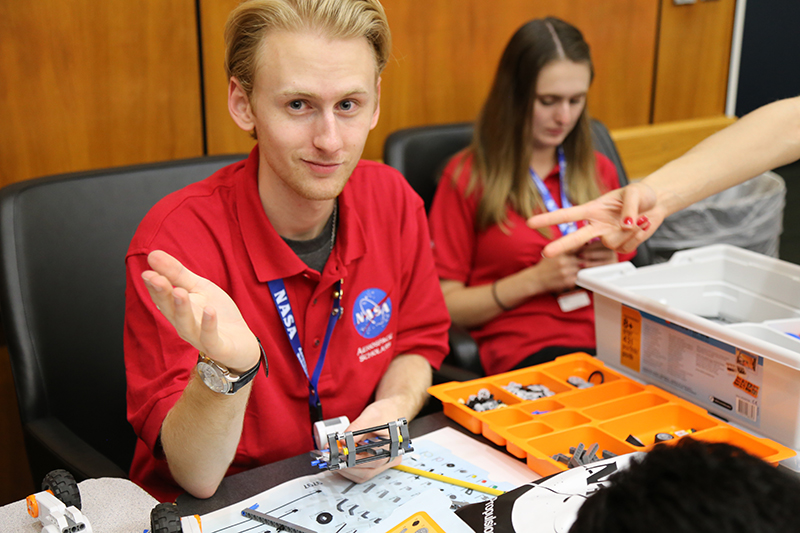
Wednesday, April 13
6:30 p.m. - Mission Two
It’s less than an hour away from the second and final mission for the teams' rovers. Tonight, the rovers must autonomously retrieve and rescue a stranded “Mars Buggy” from the simulated Mars surface. While the challenge involves a different set of commands and even changes in the design of the rovers, the lessons students learned from last night’s mission are ever present. We asked the teams to share the single biggest lesson they’re taking into tonight’s challenge:
“If we try our best, we can succeed.” – #GreenTeam

“Simplicity and planning are key.” – #BlueTeam

"No matter how much we plan for every scenario, at the end of the day, it's inevitable that mistakes will come up. As a team, we learned to push forward through the doubts and frustrations. For tonight, we will use this lesson to enhance our troubleshooting.” – #GoldTeam
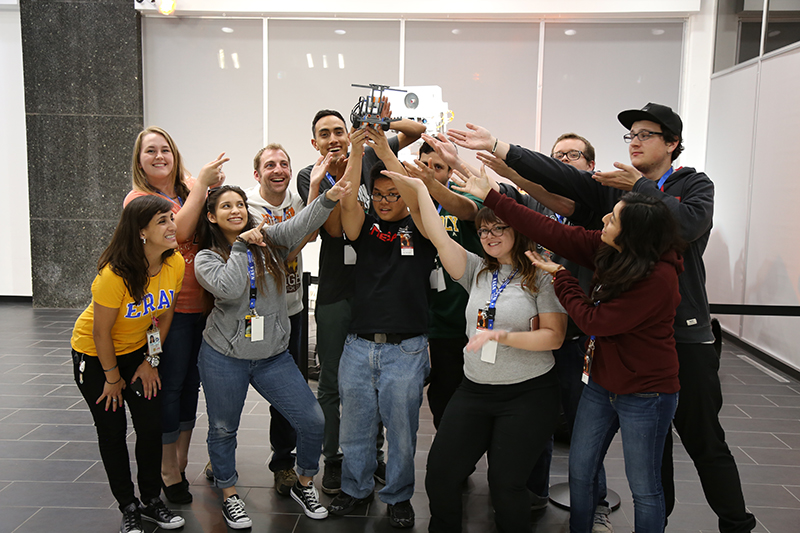
“We must embrace the unexpected difficulties” – #RedTeam
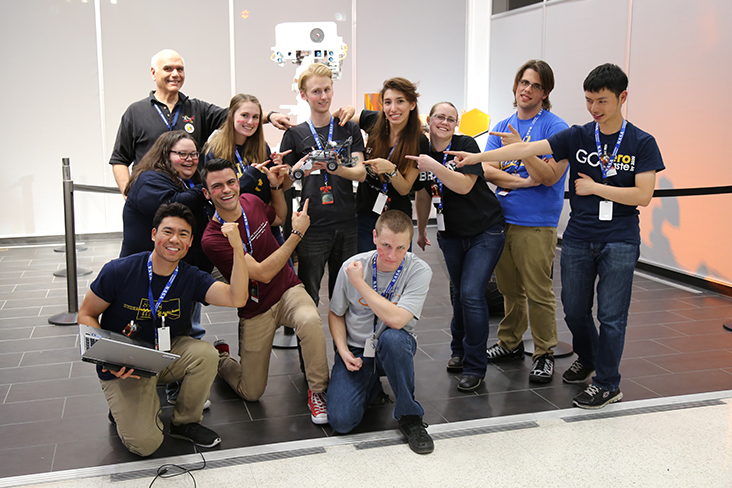
5:30 p.m. – Meet the Mentors
Each NCAS team works with a mentor who helps guide students with not just the mission at hand, but also their career missions. With four fully packed days of activities and challenges, it can be a big time commitment – especially since mentors are scientists and engineers themselves, and have their own missions and projects competing for their attention. But as we found out when we caught up with the mentors for this session, it’s well worth the hectic four days.
Amelia Quon - #BlueTeam

What do you do at JPL?
I am a mechanical integration engineer. My group builds the tools used to assemble and test spacecraft, as well as helping with the assembly and testing process. I’m currently working on a thermal-vacuum test where we’re using the 25-ft space simulator to mimic Martian atmospheric pressure, which is less than 1 percent of sea level atmospheric pressure on Earth.
How long have you been an NCAS mentor and what made you want to become one?
I’ve been an NCAS mentor since 2012. I enjoy helping the students gain confidence in their problem-solving skills as they work through the (rock and rover retrieval) missions. I participated in NASA’s High School Aerospace Scholars program as a high school student and had a great experience, so it’s nice to be able to support the program and help create similarly positive memories for the students.
How would you describe your mentoring style?
As a mentor, I try to clarify the parameters of the (rock and rover retrieval) missions for the students. I help them develop strategies for programming and building their rovers, and ask questions to encourage them to reason through problems they encounter.
What are some of the challenges or obstacles your team has faced so far and how are you overcoming them?
While testing their rover, my team discovered that many of the rocks they picked up were falling out of their basket. They went through several iterations of building and testing new designs before they came up with a design that performed as intended.
What do you most want students to take away from their experience?
I want them to realize that everyone on an engineering team is integral to the team’s success, and that setbacks and challenges can be overcome.
Luz Martinez Sierra - #GoldTeam

What do you do at JPL?
I am in the Natural Space Environments group. We are in charge of defining the radiation and debris environment that the spacecraft will encounter in space. This is very important to evaluate the risks so the designer and engineers can take the necessary measurements to avoid any failure. I am also involved with the nuclear physics instruments that are used to determine the composition of other planetary bodies or to better understand the radiation environments in space. I am also a part-time Nuclear Engineering Ph.D student at Texas A&M. I am trying to finish my Ph.D while still being a full-time employee at JPL.
How long have you been an NCAS mentor and what made you want to become one?
This is the first time I’ve been involved with NCAS, and I am loving it.
How would you describe your mentoring style?
I think I can relate with the young student quite easily. I have a younger sister, and I have done mentorships in the past. I like to get to know students and make a safe environment for them to ask me questions and to not be afraid of participation. I like to show them a strong attitude without making them scared of me. I want them to feel like they are in a collaborative atmosphere. I don’t have all the answers, but I am there to guide them in finding the answers.
What are some of the challenges or obstacles your team has faced so far and how are you overcoming them?
We had a rough start with issues regarding the division of the work. There was not a clear line between who was in charge of what, and they were focusing in one task instead of approaching it at different angles. We talked, and I encouraged the project manager to assign responsibilities and to try to make sure they still communicate with the team promptly.
What do you most want students to take away from their experience?
I want them to feel comfortable with their career, and show them that it is possible to achieve their dreams. Also I want them to realize how much can be accomplished in a few days, and make them confident of their capabilities. I want to see them succeed in life and in a professional way. They are wonderful young adults ready to take the challenge. They just need to hear it and believe it.
Otto Polanco - #GreenTeam

What do you do at JPL?
I am a mechanical engineer in the payload development group. I work with engineers across different disciplines to develop instruments and complete system payloads for various customers that come to JPL for this type of development.
How long have you been an NCAS mentor and what made you want to become one?
Since the beginning. Five years now. Wow. Already. Simple. When I was in High school, Dr. Jeff Martin, a principal for LAUSD, provided guidance on what college life was all about, how to be successful, and how to prepare for a career. Unfortunately, Dr. Martin passed away from cancer a year and a half later, but my time with him was invaluable, as he opened my eyes to the possibilities of what my future could be.
How would you describe your mentoring style?
Aggressive and hopeful, like Dr. Martin, but with a twist. No excuses. Failure is an option, but NO Quitting is permitted. I’m encouraging and pass on words of wisdom and lessons learned since my start as an intern here at JPL.
What are some of the challenges or obstacles your team has faced so far and how are you overcoming them?
Organization, laptop and programming the rover. They got organized by coming together as a team with a single leader and co-leader. Programming was done with paper and pen, then executed flawlessly when a laptop became available through great communication and team work. They have asked for help when they got stuck and/or looked bewildered. They are nervous, but they work hard and smile.
What do you most want students to take away from their experience?
Blow by the sky limit and reach for the stars. Do not place limits on what you and your future will accomplish.
Steve Edberg - #RedTeam

What do you do at JPL?
My career has been “bipolar." About half of the 36+ years I’ve been at JPL, I have worked on flight missions, from development to flight operations. The other half has been in education and public outreach. Both have been good for each other and for the projects I’ve worked on and the people I have interacted with.
How long have you been an NCAS mentor and what made you want to become one?
I have been a mentor for four or five sessions, starting in 2010 or 2011.
How would you describe your mentoring style?
For the competition, I help, encourage and suggest options. For the individuals on the team (and anyone else in earshot), I share experiences, suggest ways to successfully get into STEM as a career, and describe what we do as a human endeavor, including the anecdotes that prove it.
What are some of the challenges or obstacles your team has faced so far and how are you overcoming them?
There were not enough computers ready at the start of the design/build day. The Red Team agreed to wait for delivery of theirs, but that took much longer than expected, and it wasn’t ready to use and needed technicians to get the software working as designed. This delay strongly affected the software team and limited their ability to make a more complete set of command routines. The software team built sufficient routines for the rock retrieval challenge by making maximum use of the software and technology available for the challenge. To their credit, they did this on their own.
What do you most want students to take away from their experience?
I want them to remember this as a taste of the real thing. I want them to realize that finding what THEY want to do (individually) is what they should aim for, and that they should aim high. They should come away knowing that space exploration, and each part of STEM, whether exploring space or not, is a wonderful, challenging, and joyous way to spend a lifetime.
2 p.m. - Networking Challenge
Students spent the morning touring the Space Flight Operations Facility, also known as mission control, and the Mars Yard, a simulated Mars terrain where engineers test maneuvers for the Curiosity rover.
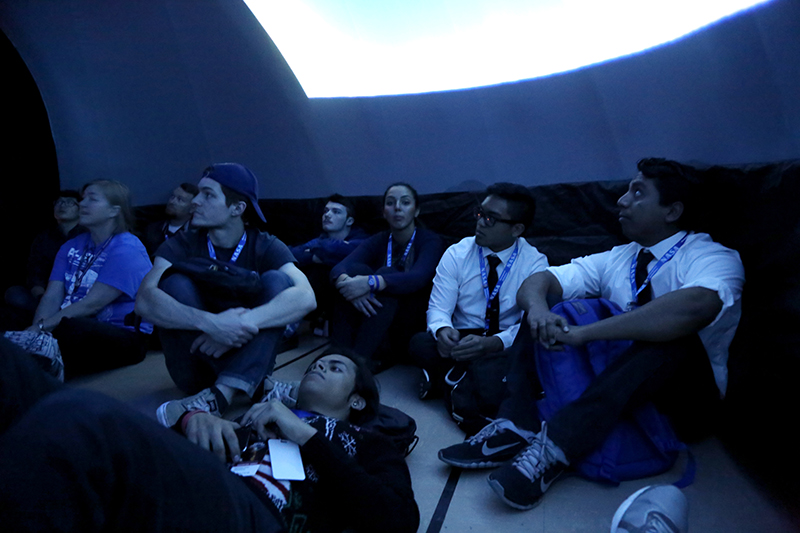
Then it was time to get up close and personal with the people of JPL during NCAS' first-ever Networking Challenge. Shannon Barger of JPL's Education Office came up with the idea for the challenge: "The best way to move forward [at JPL and in your career] is to get your name out there and have connections."
So, armed with questionnaires (that served as networking icebreakers of a sort) students caught up with JPLers as they were out in full: during lunch.
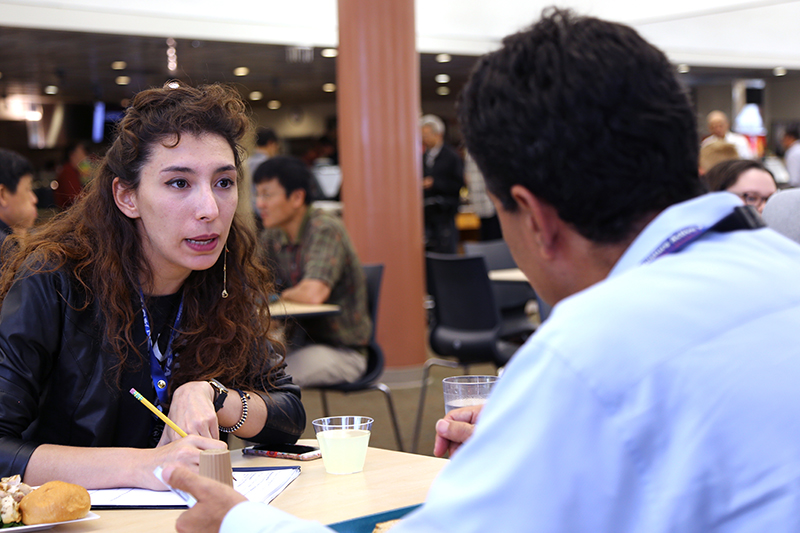
It turned out that JPLers were just as excited to talk to NCAS students as the students were to talk to JPLers. More than a few students were asked for their resumes and others left with promises to attend the presentations tomorrow. The students said they were impressed by the diversity of people and careers at JPL, which they learned can include such things as ripple effect engineering and planetary science.
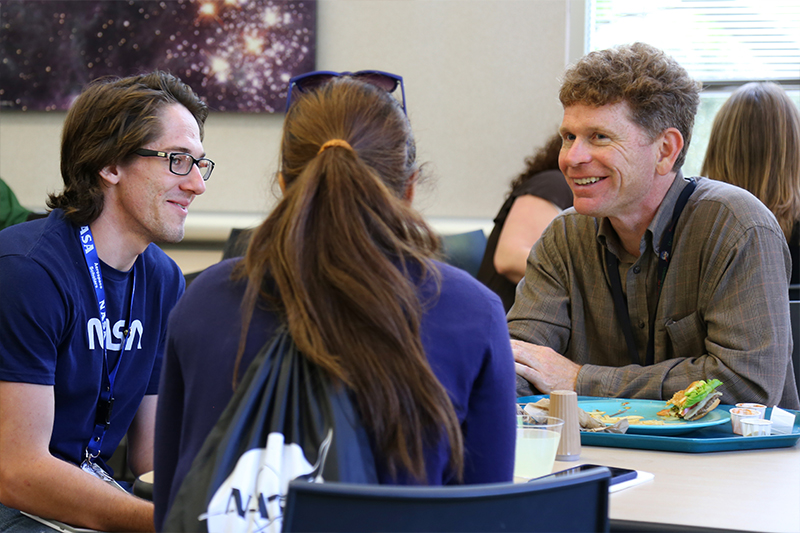
"I love that you can go talk to anyone at JPL and they'll talk to you for an hour about what they do," said Scott Hall, a member of the Green Team who's studying mechanical engineering and physics at Ohlone College in Fremont, California.
Roslyn Soto and Eddie Gonzales, who manage the NCAS program for JPL, said they hope to make the challenge a regular part of the on-site experience.
Tuesday, April 12
9:35 p.m. – Mission One
After a full day of listening to inspirational speakers, building rovers, programming them and testing them, the teams were ready for their first mission. One by one, each team brought their rover to the mission site where they were given a two-minute trial run followed by one minute to make modifications to their rover. Once the modification window elapsed, teams had 10 minutes to command their rover to autonomously collect as many rock samples as possible.
Having completed the mission, teams retired for the evening, their scores to be calculated and added to the cumulative total at the end of the program.

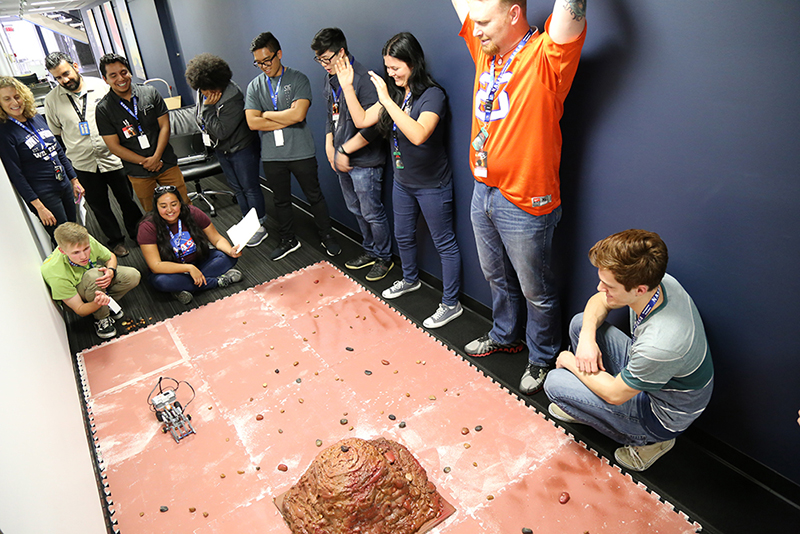
5:45 p.m. – What's Your Strategy?
While each team has the same mission in mind, their approach and strategy can vary wildly. The team members’ personalities and experience, their mentor and any challenges they face along the way all make an impact on the outcome of their final mission. Tonight, the teams will compete in their first mission, which involves programming their rovers to autonomously collect and transport rock samples on the simulated Mars terrain. As the teams learned earlier in the day from Mars rover engineer Rob Manning, it all comes down to the team with the most thorough design and testing – plus a bit of luck. We wondered what each team's strategy or motto is going into the challenge, so we asked them to describe it in five words or fewer. Here’s what they said:
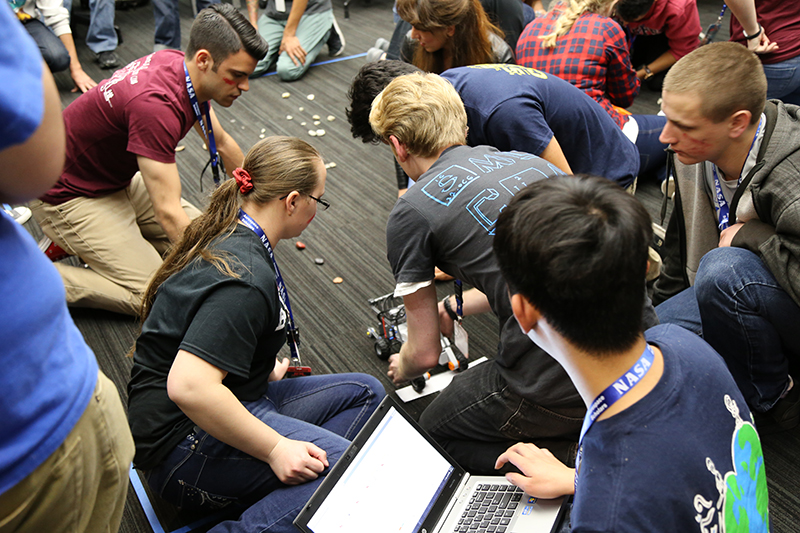 “Every action requires team heart” – #RedTeam
“Every action requires team heart” – #RedTeam “Simple, efficient, applicable, logical science” – #BlueTeam
“Simple, efficient, applicable, logical science” – #BlueTeam
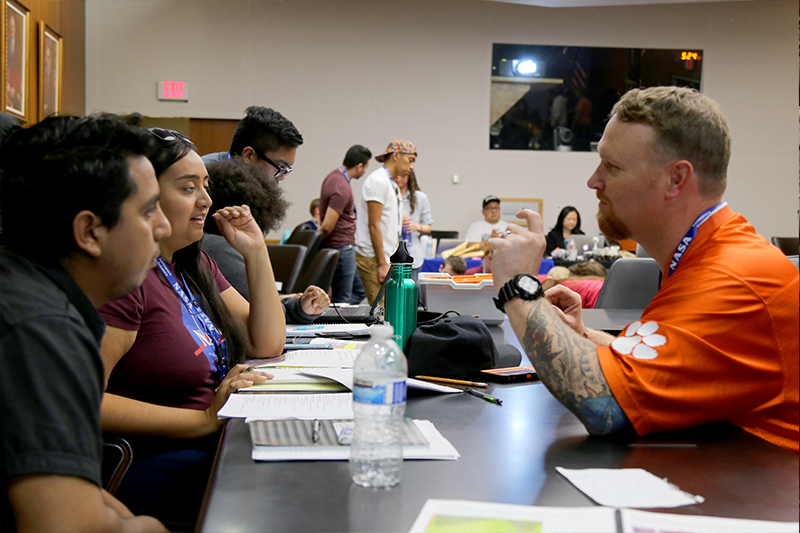 “Forward, drop, drag” – #GreenTeam
“Forward, drop, drag” – #GreenTeam
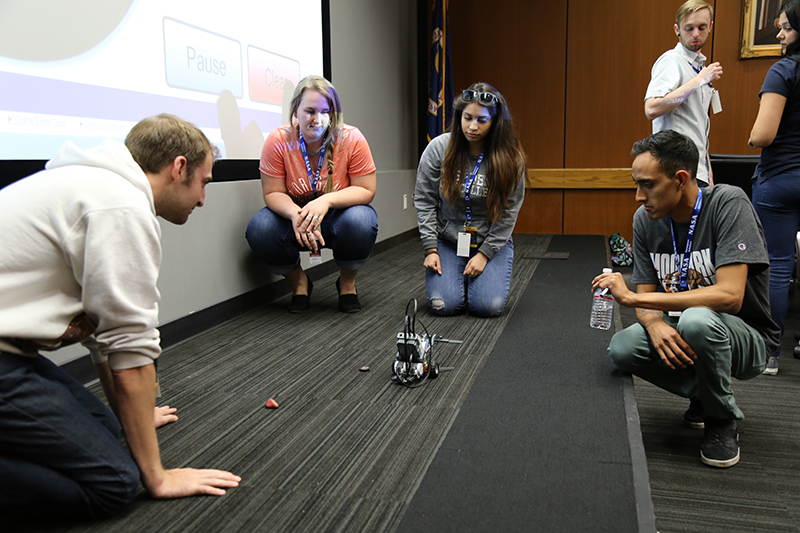 “Off-world specimen cache and retrieval” – #GoldTeam
“Off-world specimen cache and retrieval” – #GoldTeam
Tell us which one is your favorite and wish them luck on Facebook and Twitter, using #NCAS2016 and the team hashtag.
3 p.m. – Their Mission, Should They Choose to Accept It
As soon as students arrived at JPL yesterday, they began working on what will be their mission for the next three days: building a working Mars rover prototype that can perform two separate missions on a simulated Mars terrain. The rover doesn't look like much. It's an amalgamation of LEGOs and a programming console. And the Mars terrain consists of red floor tiles with sand, colored rocks and a faux Olympus Mons. But despite the looks of it all, the challenge is just about as close as it gets to the real thing.
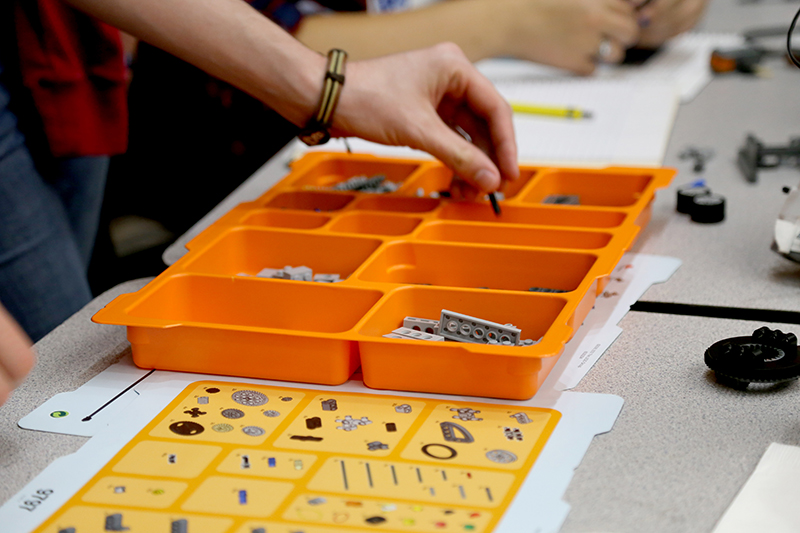

The students are divided into four teams, each lead by a JPL mentor, and are assigned project roles such as project manager, software engineer, even marketing and communications manager. On Day One, teams are given a $600 million budget to build a rover that can successfully complete two missions: gather and transport sample rocks, and later rescue and retrieve a stranded "Mars Buggy." They then have to design and build their rovers using a LEGO Mindstorm kit with various parts that are each assigned a dollar value. They are allowed to purchase and sell parts from other teams, but they can't exceed their budget. Monetary fines and bonuses are given for things like losing equipment (fine) or asking good questions (bonus). Teams are also awarded money for performing successful maneuvers during their missions.
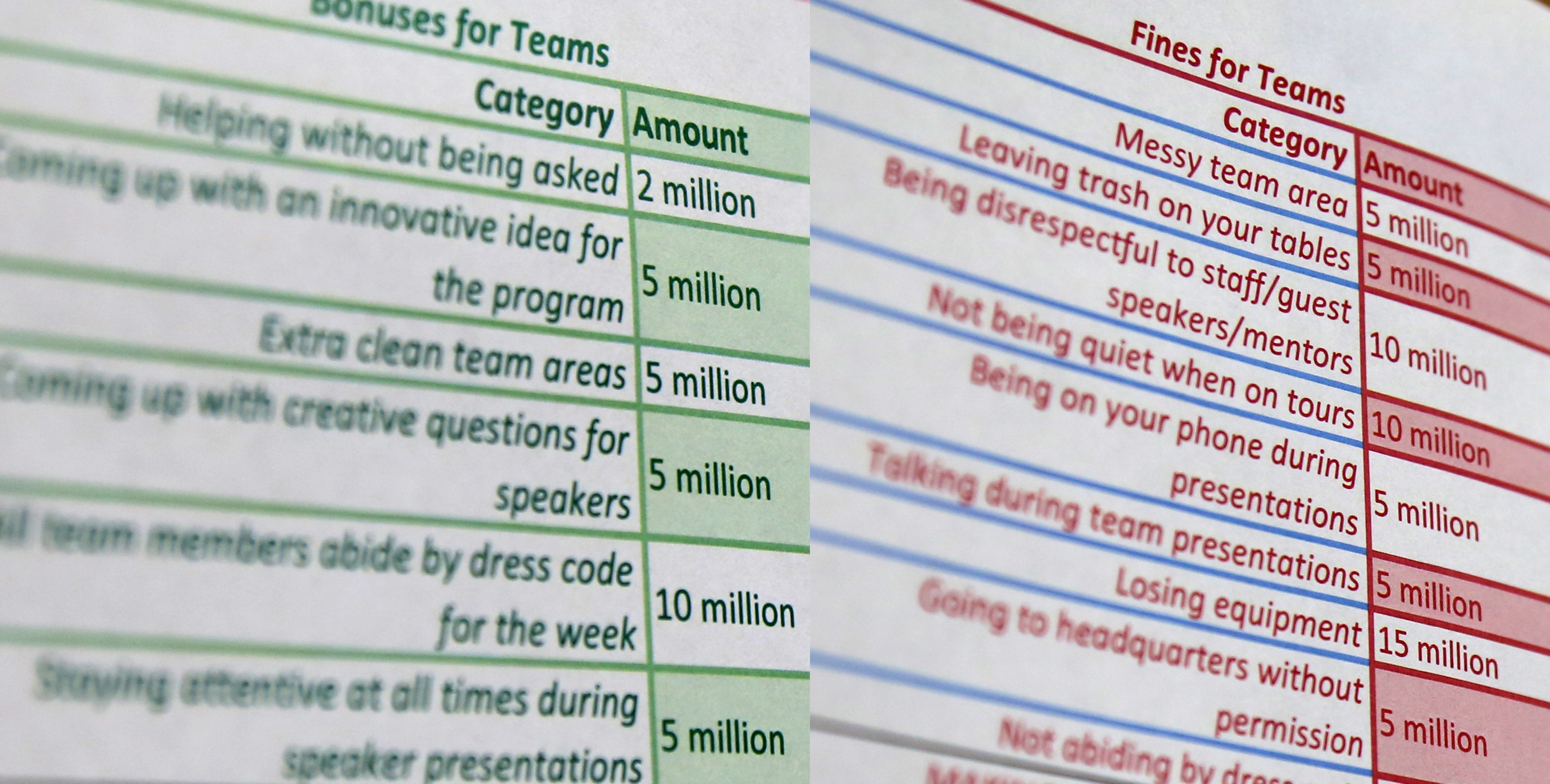
On the final day of their experience, teams will make final presentations to a mock NASA mission selection panel, during which they will have to explain their rover's scientific objective and sell their design.
"We push them to take on roles outside of their comfort zones, to speak up and have their voice heard and to learn from each other," said Roslyn Soto, who along with Eddie Gonzales helps manage the program for JPL. "We want students to have a good understanding of the kind of teamwork that is required in engineering and other STEM fields and walk away with a better understanding of the research and career opportunities available to them."
12 p.m. – Lessons from a Career Mars Rover Engineer
The students took a break from building their rovers to hear a talk by Rob Manning, the chief engineer for the Mars Curiosity rover. Manning has been a Mars rover engineer since the Pathfinder mission of the 1990s, which landed Sojourner, the first rover ever on the Red Planet.
He shared his experiences designing and building rovers for NASA and how the process has evolved during his 35 years at the laboratory.
"Can you believe that JPL started building its first spacecraft the year I was born, 1958. These people were building spacecraft without the use of computers. Everything was done by hand. So if you wanted to design [a spacecraft], you had to draw out all the details on a piece of paper."
On building spacecraft for Mars, he said:
"What I like about building spacecraft for Mars is you can build it, design it, test it and launch it, and in seven months, it's on Mars. So the very same people who thought of it, can operate it."
Students used the opportunity to ask Manning about some of the more creative engineering solutions his teams have come up with over the years, such as the bounce landing used for the Spirit and Opportunity rovers.
"Back then people thought we were really goofy by doing that. 'So you're going to land how many times?' Imagine dropping your spaceship from 23 meters on another planet."
He stressed the importance of designing spacecraft with potential issues in mind, but said a lot of it comes down to luck.
"Sometimes you get lucky. And the trick is to design your systems so you think of these things. In many respects, what happens on the day of landing is out of our control. In some sense, the future has already happened because if it doesn’t work, it’s because of something we missed or we didn’t test ahead of time."
11 a.m. – Welcome NCAS 2016 Students!
Forty community college students descended on NASA's Jet Propulsion Laboratory yesterday for a four-day experience and engineering competition hosted by NASA's National Community College Aerospace Scholars, or NCAS, program. The program, which consists of a five-week online course, webinars with NASA scientists and engineers, a project planning a mission to Mars, and the opportunity to qualify for a four-day on-site experience at a NASA center, is designed to give community college students a window into science, technology, engineering and mathematics careers at NASA. Of the nearly 300 accepted for the online workshop, 120 are invited for an on-site experience at a NASA center.
This week JPL, Johnson Space Center, Armstrong Flight Research Center and Stennis Space Center are hosting 40 students each for the Spring 2016 on-site experience, during which student teams will compete to win a fictional mission contract for a future Mars rover. Teams must design and build their rovers using a LEGO Mindstorm kit, test them on a simulated Mars surface and finally sell their mission concept to a panel of NASA experts. Each of the four teams at JPL is guided by a laboratory engineer, who will mentor them throughout the competition.
TAGS: NCAS, Community College, Programs, Workshops, STEM, Robotics, Engineering
Edu News | December 3, 2014
Mini Rovers Hold Big Promise for Community College Students
Four miniature rovers will go head-to-head this week at NASA's Jet Propulsion Laboratory in Pasadena, California, as community college students across the state - and one from Hawaii - get a first-hand look at what it's like to work on a robotic space mission.
Wednesday marked the start of the fall 2014 session of the NASA Community College Aerospace Scholars, or NCAS, program, a three-day workshop designed to give community college students a window into the science, technology, engineering and mathematics universe and launch them into future internships and careers at NASA.
To qualify, students took a five-week online course on Mars exploration and were tasked with designing a rover to explore a Red Planet destination of their choosing.
"I focused on the sustainable efforts side," said Arleena Faith, a computer science student at Santa Monica College, who's working on bringing her design skills into the Web development world. "You spend billions of dollars building one of these sophisticated rovers and suddenly it hits something, and you've lost it. So why don't you have a small rover that's like a ball. It rolls everywhere and it helps determine whether the terrain is safe enough for the main rover."
Based on their scores from the design challenge and online course, 40 finalists were chosen to take part in the workshop at JPL. Johnson Space Center in Houston and Marshall Space Flight Center in Huntsville, Alabama, are also hosting their own NCAS student teams this week.
While at the NASA centers, students meet with engineers and scientists, and teams compete in their biggest challenge yet: Building a rover that can navigate through everything from a simulated Martian terrain to budget constraints to win the coveted "mission contract."
The rovers are only about the size of a brick, but they carry a heavy load: The futures of aspiring engineers and scientists.
For Laura Medina, a 24-year-old aeronautical engineering student at San Bernardino Community College, participating in NCAS is a chance to prove to herself that she can.
"At first I was nervous because I feel like I've never been smart enough," said Medina, who after dropping out of high school to help her mom take care of her younger siblings, decided to get her GED and enroll in college so she could fulfill her dream of becoming an engineer. "But I've gotten this far. I've been able to do these things on my own."
For other students at the brink of their next educational leap, it's about getting a push in the right direction.
"I'm sure this experience will help me home in on what type of career I want to go into," said Arlene Lopez, a mechanical engineering student at El Camino College. "I'm leaning toward working with spacecraft."
Khanh Pham is pursuing her lifelong interest in mathematics at Orange Coast College and hopes to become a teacher -- unless, she says, NCAS changes her mind.
Right now, my career goal is to become a math teacher," said Pham, a 39-year-old mother of two who emigrated from Vietnam a little more than two years ago. "But somebody told me that maybe after this trip, I'll want to change my major to aerospace engineering."
Student teams met for the first time on Wednesday to begin preparations for the rover competition, but for many, the draw of seeing a NASA center in person and working with professional engineers and scientists is just as exciting.
"I'm just looking forward to going to JPL," said aerospace and mechanical engineering student Jose Salinas, who's in his second year at Bakersfield Community College. "It'll be my first time at any NASA center, so I'm just really excited. I think nervousness is out the window. I'm just really stoked to go."
For more information on the NCAS program and to apply, visit: https://ncas.aerospacescholars.org/
Learn more about JPL internships and fellowships
NCAS is funded by NASA, managed by the Johnson Space Center, and coordinated locally by the JPL Education Office.TAGS: Women in STEM, NCAS, NASA Community College Aerospace Scholars, Community College, Internships & Fellowships, Robotics
Meet JPL Interns | August 20, 2014
Going the Distance
I grew up moving around in the U.S. and Mexico, which made it hard to
keep up with school. I mainly struggled with my language arts classes,
but there were areas in which I excelled: math and science. I was in
high school when I decided I wanted to be a scientist; I was fascinated
by the explanations of the world through chemistry and physics. Although
I was living in Mexico at that time, I never gave up on the dream of
attending an American university to pursue my education. In 2010, my
family and I moved to California.
I was already a high school senior in
my last semester when I enrolled in school. I had already missed all
the university deadlines, hadn't taken the SATs and had to attend adult
school in the afternoon to make up for missing credits. Despite all of
that, I graduated on time and decided to attend the College of the
Sequoias, a local community college, where I am now majoring in
chemistry. (I will be transferring to the University of California, Los
Angeles in the fall!)
During my freshman year, I heard about the NASA National Community
College Aerospace Scholars Program, and I decided to give it a shot. I
used my basic knowledge of chemistry to write a series of proposals for a
mission to Mars that included a timeline, budget and rover design.
Based on my individual performance, I was selected on a competitive
basis to attend the on-site team project at NASA's Jet Propulsion
Laboratory. There were about 40 students from all over the U.S. We were
split into four teams to put our ideas together and build a rover. We
called our team "Red Planet Research" and our rover was named "Isis."
(It was my birthday!) Through this I experience, I saw what it takes to
be a NASA scientist and engineer. I also discovered that I wanted to
become one of the JPL scientists who are involved with exploration
missions. I was hooked on studying the Earth and planets. I returned to
my school excited for what was to come and shared my excitement with
others. I am happy to say that four students from my community college
participated in NCAS this year at JPL.
In August of 2013, I
received an email from NASA Education saying that I had been selected to
receive the Minority University Research and Education Program (MUREP)
scholarship! The program guarantees two summer internships at any NASA
center. Right away, I knew I wanted to come back to JPL. Although I come
from a small community college, I managed to be a competitive applicant
due to my involvement with science, technology, engineering and
mathematics programs, such as the Mathematics Engineering Science
Achievement Program and the Society for Advancement of Chicanos and
Native Americans in Science.
This summer, for the first of my
two NASA internships as a MUREP scholar, I am working in the
AstroBiogeoChemistry (ABC) Lab measuring hydrogen and oxygen isotopes in
hydrated clay minerals. Our goal is to improve instrument precision and
techniques for possible future return-sample missions.
It's a
dream come true to finally work in a planetary chemistry and
astrobiology lab. I have the opportunity to meet researchers who are
passionate about their work and be involved in exciting research. But I
think the best part of the internship is my lab group. There are two
other interns, two post-doctorate interns, a Ph.D. student, and my
mentor. They all take the time to tell us about the work they're doing
and, most important, mentor us as rising scientists. Throughout my
experience, I have learned a lot about research, and I am inspired to
continue in the STEM field. I was nervous before coming to JPL and
didn't know what to expect, but being part of the ABC Lab has exceeded
all my expectations. I encourage all community college students to apply
for NASA opportunities.
Although my internship is coming to an end, I am happy to say that I will be back next summer to do more exciting research.
Learn more about JPL internships and fellowships
TAGS: Women in STEM, NCAS, Community College, Internships & Fellowships, Chemistry, Planetary Science, Astrobiology, Geology, Women in STEM, Hispanic Heritage Month, Women at NASA
Edu News | December 12, 2011
Professor Inspires with Help from NASA Curriculum Improvement Program
Growing up in the Philippines, Amelito Enriquez knew nothing of high expectations. He wasn't expected to be the first student in his high school's history to go to a university - especially for a degree in engineering. He wasn't expected to receive the highest grade point average in the engineering department's history -- he wasn't even expected to be more than a "C" student. He wasn't expected to continue his education in the United States and become one of the country's most inspirational educators. And he wasn't expected to receive a presidential honor for his career-long commitment to helping underprivileged youth succeed.
"I like proving people wrong," said Enriquez, a professor of engineering and mathematics at Cañada College in Redwood City, Calif., who recently received the Presidential Award for Excellence in Science, Mathematics, and Engineering Mentoring. Over the years, he certainly has.
It was sixteen years ago that Enriquez first discovered his calling. "After grad school, I started applying for teaching jobs at four-year institutions," said Enriquez. "Being from the Philippines, I didn't know about community colleges. When I realized what they were, I thought, this is me. I knew I could really make a difference at a community college." Turning down multiple offers at four-year institutions, Enriquez began his career at Cañada College in 1995 and never looked back - except when his mentor periodically phoned him to see if he'd reconsider the university route. He wouldn't.
Enriquez's students start very much like he did. They come from disadvantaged backgrounds where expectations are at a minimum, if not nonexistent. "The students I work with score high enough to be accepted into community college," said Enriquez. "But their math and science scores are below average. A lot of them are at the high school algebra level."
Inspiring these students to go from barely getting by to reaching way beyond anyone's expectations is Enriquez's passion, and he achieves it through a variety of grants and programs. One such program - which Enriquez says has given his students the rare opportunity to get hands-on research experience - is NASA's Curriculum Improvements Partnership Award for the Integration of Research, or CIPAIR. CIPAIR brings minority college students and their teachers to NASA centers for research projects aimed at improving curriculums for future generations of students. Through their experiences with the NASA program, Enriquez and his students have so far contributed to more than a dozen curriculum improvements at Cañada College, adding activities and lessons on launching satellites, designing a Mars rover and more.
"As a result of CIPAIR, our students are more confident about succeeding in a four-year school," said Enriquez. "And almost all of them are now considering advanced degrees."
In early December, Enriquez flew to Washington D.C. to accept his mentorship award from President Barack Obama. While Enriquez considers it a great honor to be recognized for his hard work, he says that in a way, he already feels rewarded. "As part of the application process, my students had to write letters about why I should be recognized," he said. "A lot of students wrote in. Just reading those letters was really more of an honor than I could ask for."
It's also proof that inspiration goes a long way. "That's the best thing a teacher can give to a student," said Enriquez. "It's inspiration. It's to get kids to do something bigger than themselves."
TAGS: Community College, Educators, Fellowships, Cañada College
Edu News | May 3, 2011
Community College Students Simulate Rover Mission
What does it take to plan a rover mission to Mars? Thirty-nine students from community colleges around the country visited NASA's Jet Propulsion Laboratory in Pasadena, Calif., for a three-day "boot camp" to plan, design and build a working model for a robotic journey to the Red Planet.
The students participated in NASA's National Community
College and Aerospace Scholars (NCAS), a program for students interested
in science, technology, engineering and mathematics. Now in its second
year, the program is managed by NASA's Johnson Space Center and
provides hands-on projects that feature possible careers in engineering.
"This program helps fill a gap in the education pipeline," explained NCAS Program Manager Deborah Hutchings. "We have a program that allows community college students to get a taste of a real NASA mission, from planning a budget, to making line drawings and even testing their designs. It takes them through a compressed mission development cycle." On the final day, teams make presentations and compete to see which rovers can maneuver over a simulated terrain.
One alum from last year attests to the program's impact. "I feel like this has put me on the road to working at NASA," said Cliff McKenzie, a mechanical engineering student who attended Wake Technical Community College in Raleigh, N.C., when he was in the program. He is now an intern at JPL with the NASA Undergraduate Student Researchers Program. "I think students are surprised by the kind of people who work here. Scientists and engineers are sociable and friendly, not locked in their offices just crunching numbers."
TAGS: NCAS, Community College, Internships & Fellowships





